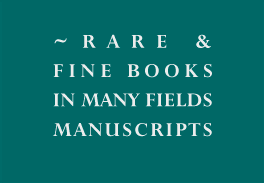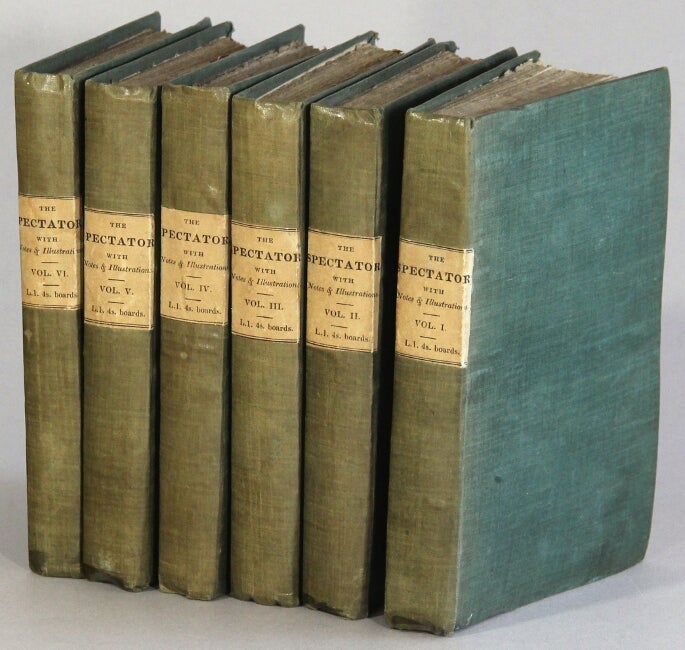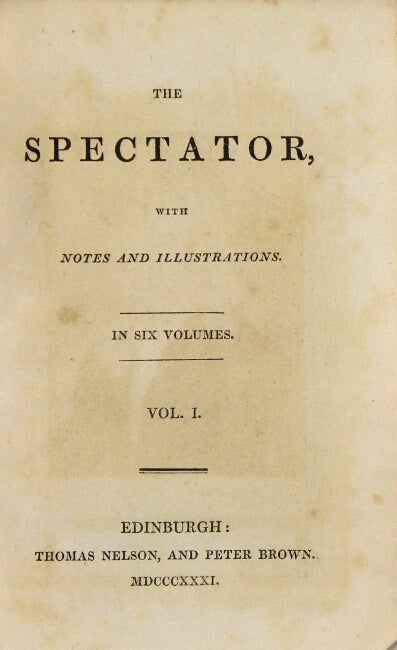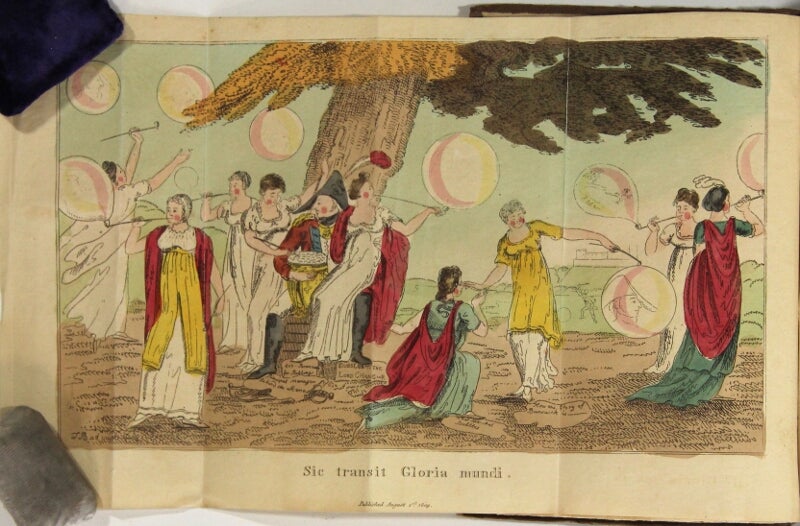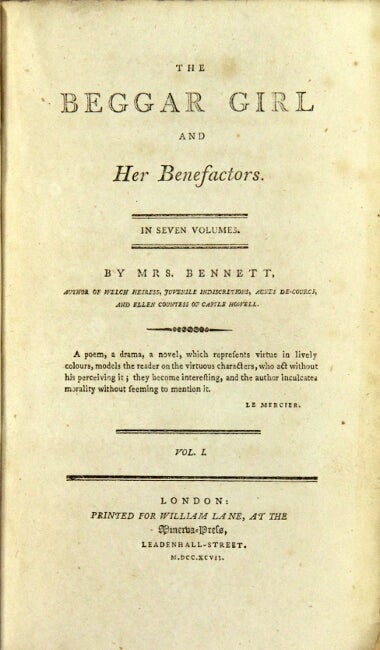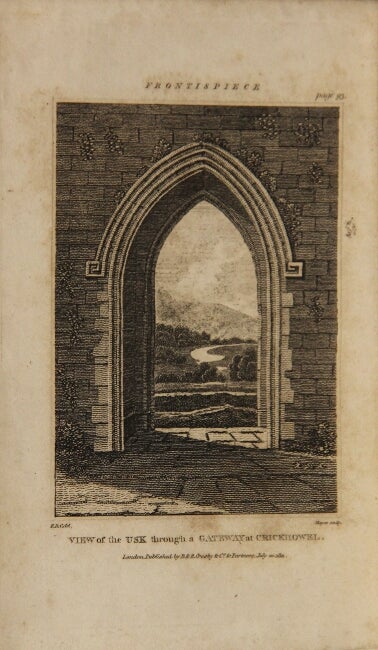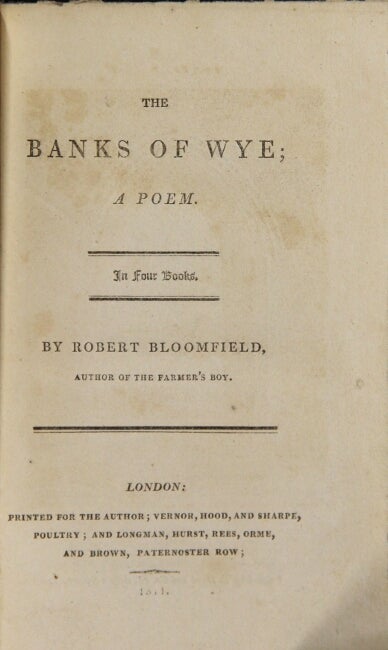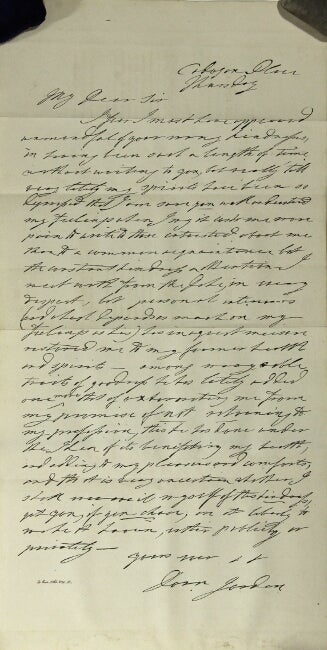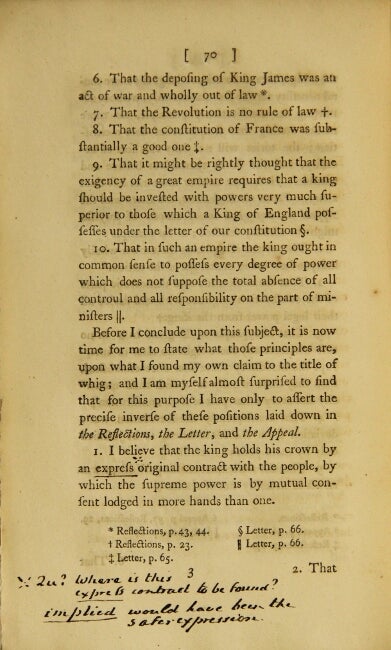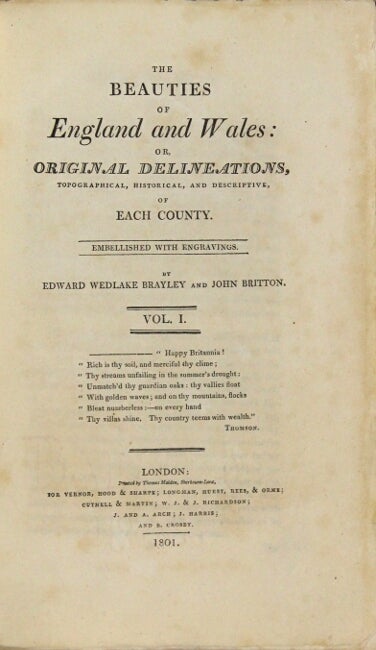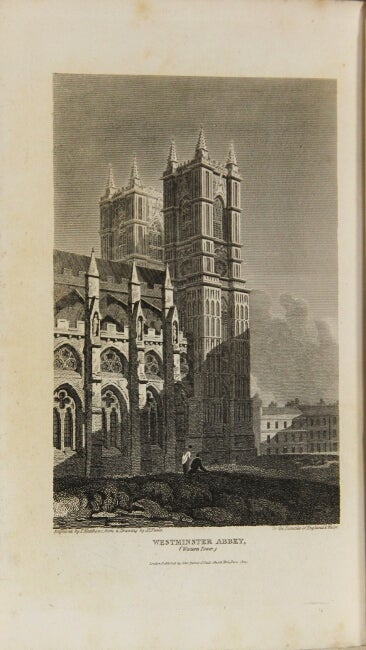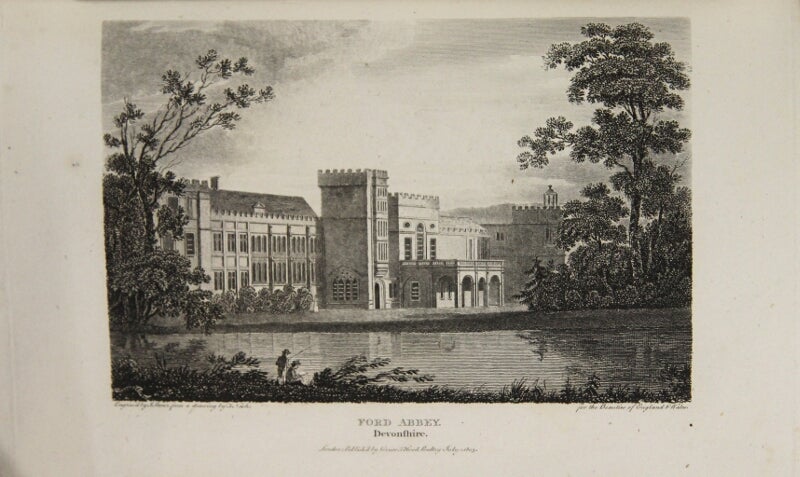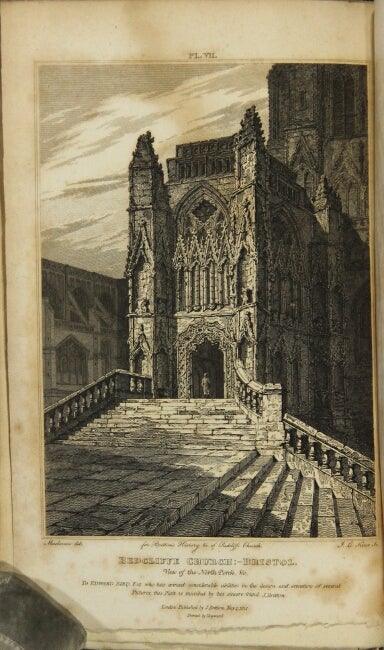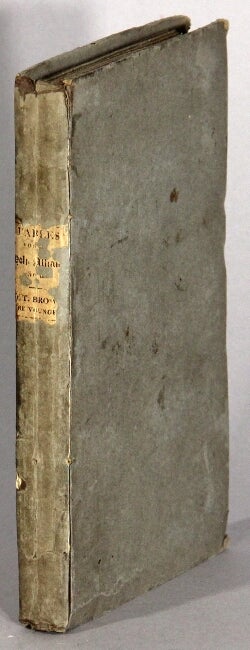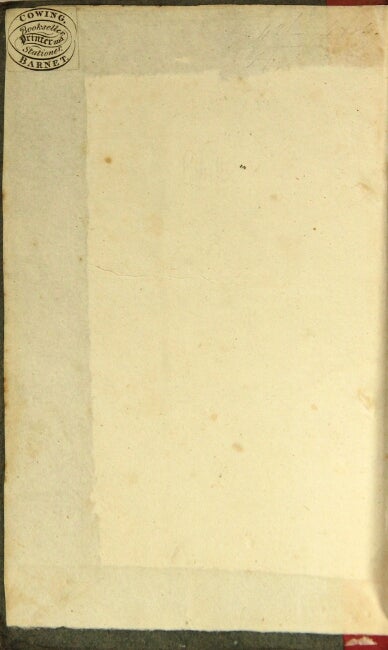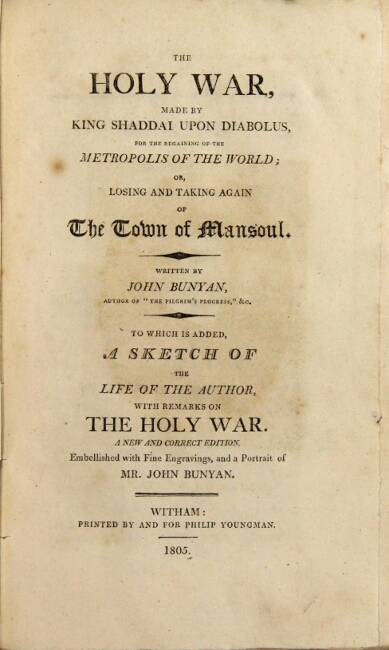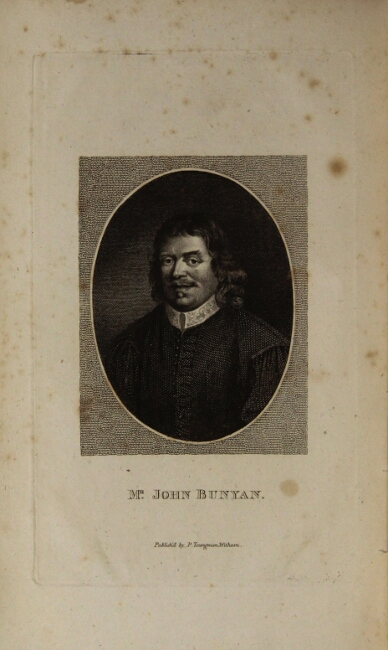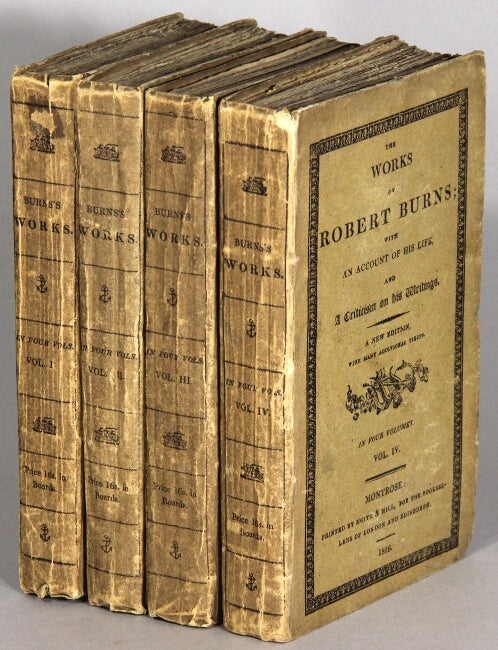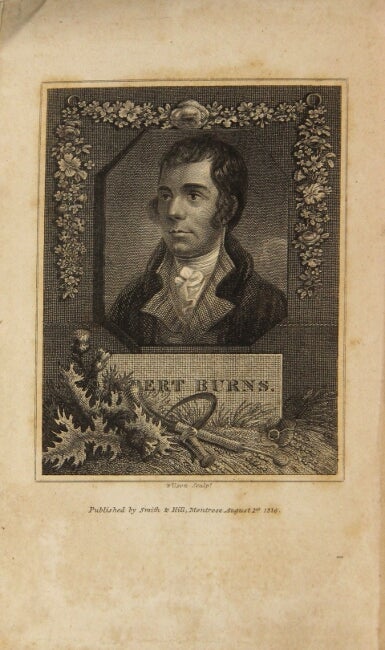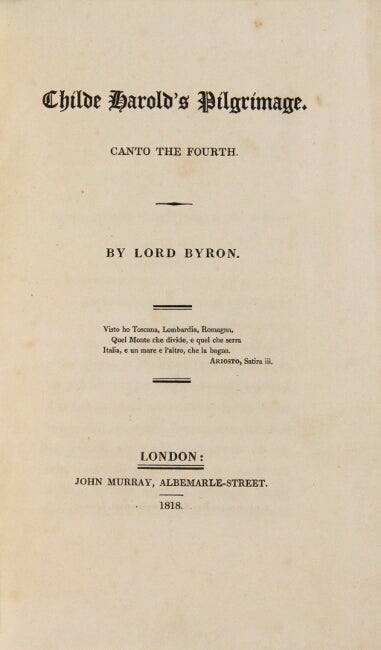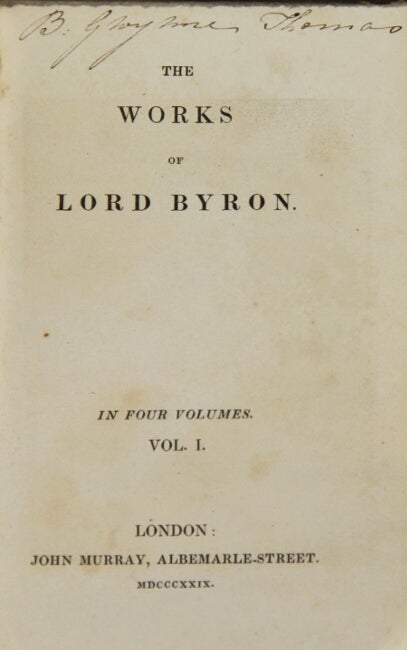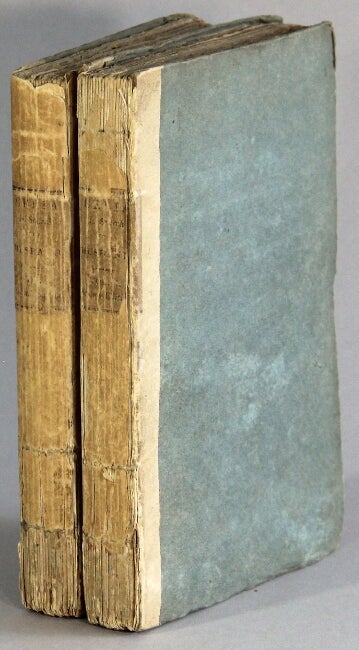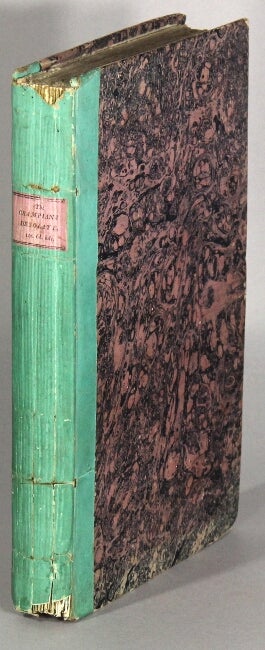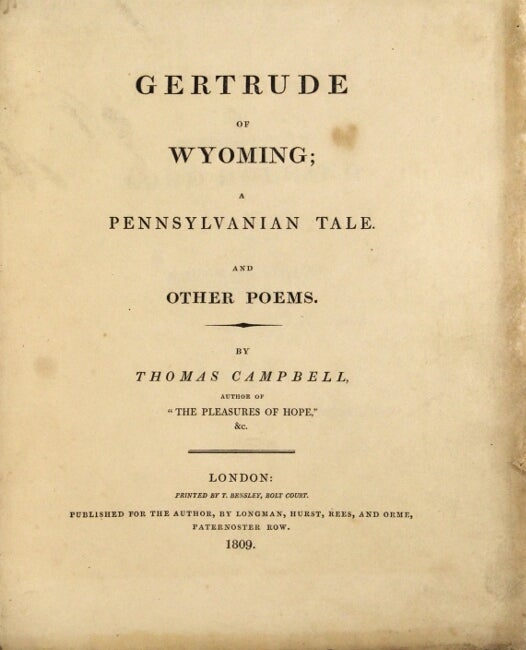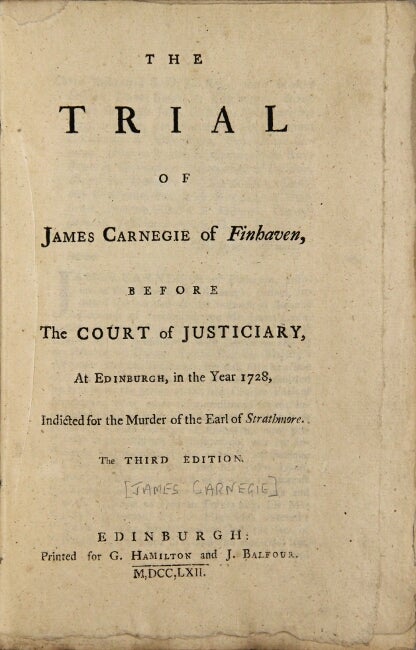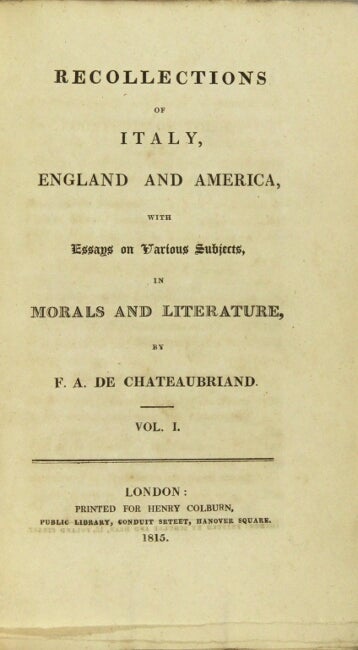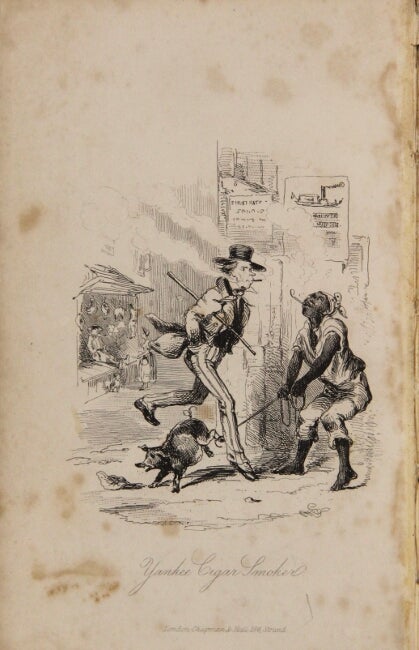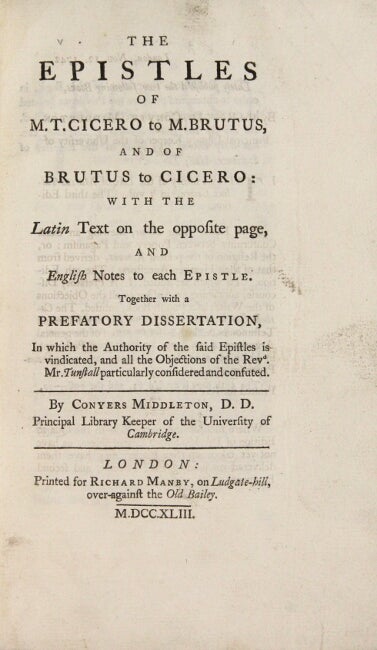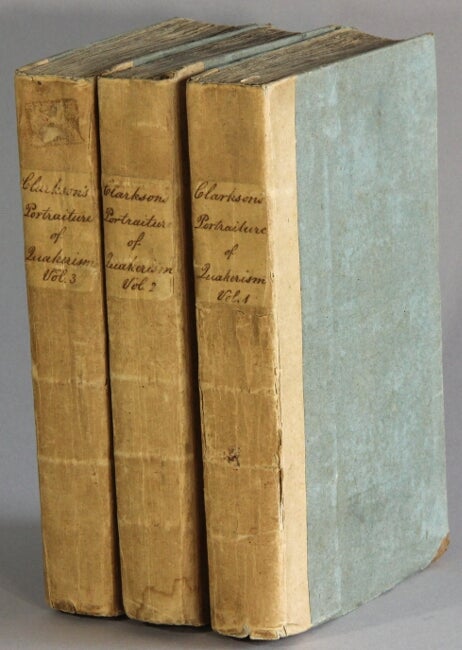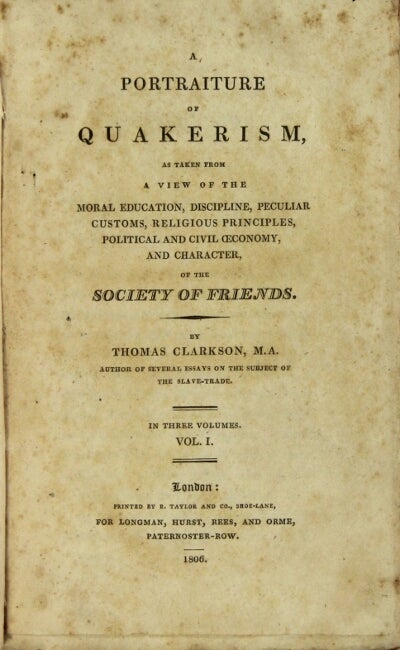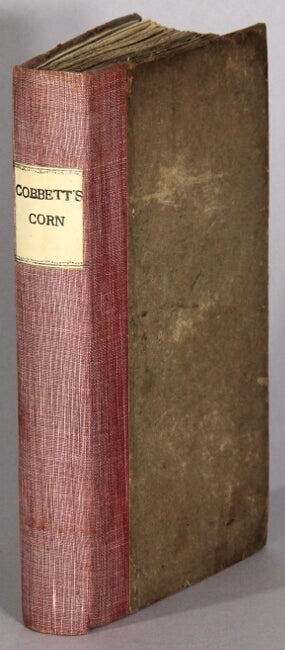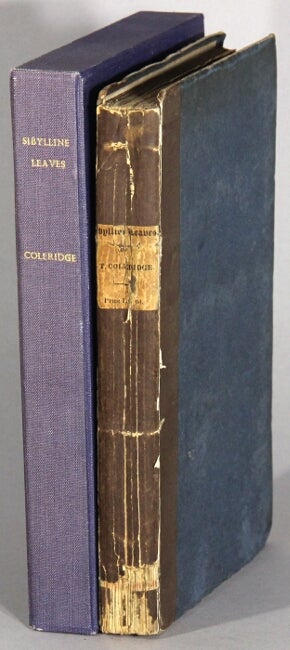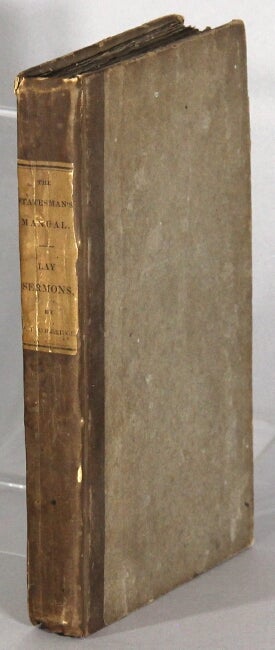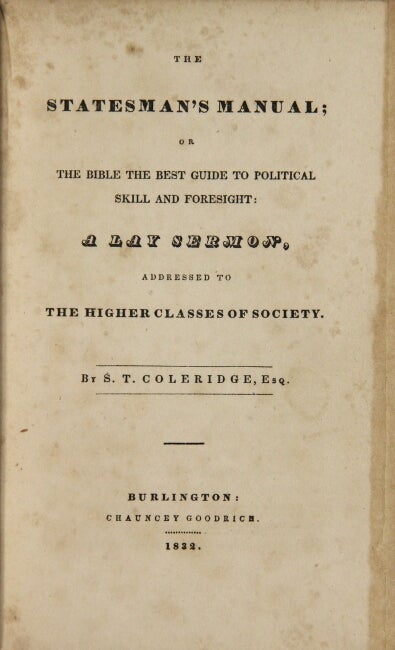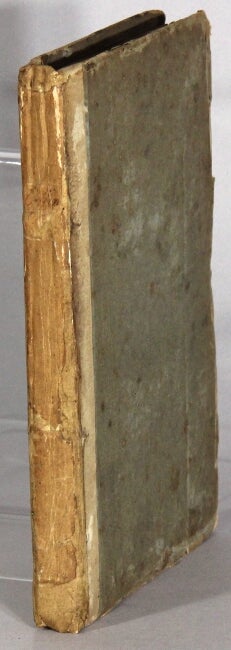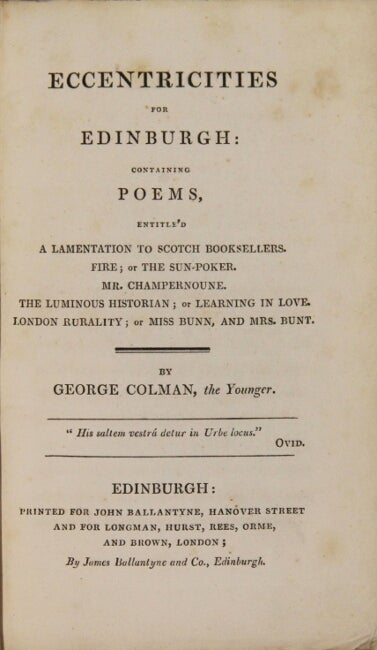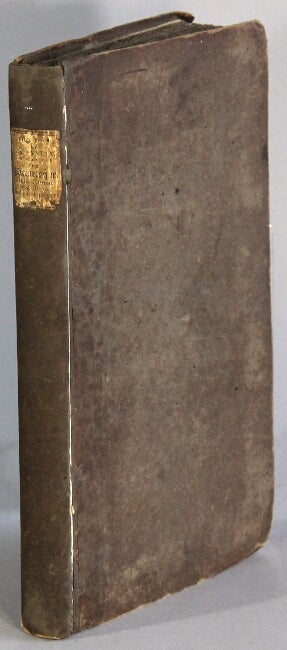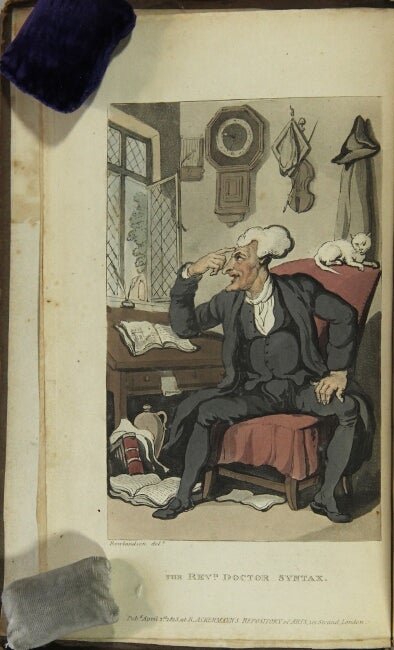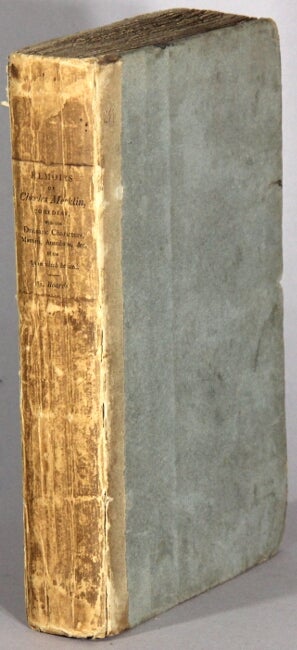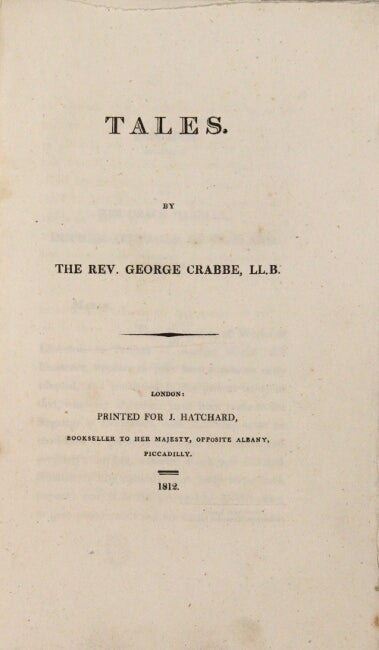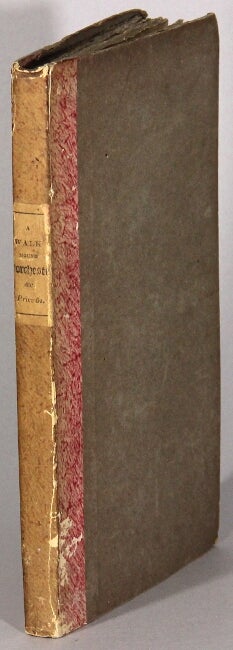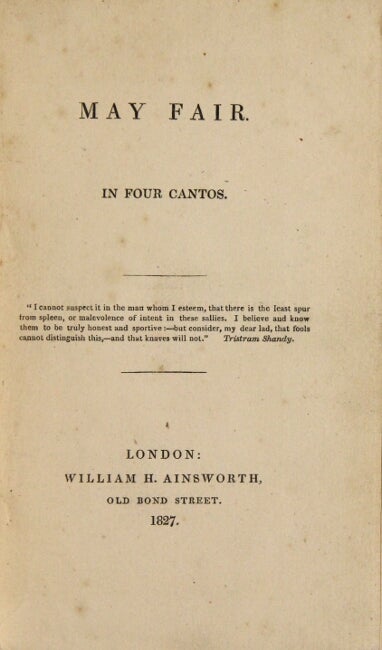In Boards, Uncut (Part 2)
Catalog 170
To order call toll-free at (800) 441-0076 or 651-290-0700
or email rulon@rulon.com
or, click on the "add to cart" link to order through our website. Phone calls and emails are generally quicker.
All books are guaranteed genuine as described, and are returnable for any reason during the first week after receipt. If you are returning an item, please let us know so we can make it available to another customer.
Shipping and handling charges are extra and billed at cost.
To see Part 1, Click Here


A note on OCLC
As is now the norm, OCLC counts are tentative, at best, as we recognize that searches using different qualifiers will often turn up different results. Searches are now further complicated by the vast numbers of digital, microfilm, and even print-on-demand copies, which have polluted the database considerably, making it difficult, without numerous phone calls or emails, to determine the actual number of tangible copies. Hence, even though the counts herein have been recently checked, most all should be taken as a measure of approximation.

2-1. The spectator, with notes and illustrations. Edinburgh: Thomas Nelson, and Peter Brown, 1831.
$450
12mo, 6 volumes; portrait frontispiece; original full green muslin, printed paper labels on spines; spines a touch sunned, a few corners lightly bumped, the cloth cockled in places, frontispiece and edges with the occasional foxing, text uncut, with the later volumes largely unopened, very good. Pages 281-282 and 381-382 of vol. 1 have been transposed due to binder's error. Armorial bookplates of Augustus Terry Clarke.
An early example of a publisher's full cloth binding. Addison and Steele contributed the bulk of the essays in the series, though some items are attributed to others, including Pope. Despite the subtitle, “with notes and illustrations,” whose wording is repeated on the spine labels, there are no notes in this edition, and only one illustration, the frontispiece in volume I, an engraved portrait of Addison, after Sir Godfrey Kneller’s painting and engraved by William Finden.

2-2. Letters from Flushing; containing an account of the expedition to Walcheren, Beveland, and the mouth of the Scheldt, under the command of the Earl of Chatham; to which is added a topographical and statistical account of the islands of Walcheren and Beveland. London: printed for Richard Phillips, Bridge Street, Blackfriars, 1809.
$275
First edition, 8vo, pp. [2], ii, 288, 16 (Phillips catalog); folding frontispiece map, 2 other folding maps; original blue paper-covered boards, printed paper label on spine; front endpapers and frontispiece dampstained, spine worn with small chips out, label chipped with loss of one letter; a good, sound, and but for the initial dampstains, clean copy. On the front pastedown is armorial bookplate for Robert Montgomery / Convoy.
Wikipedia notes that "The Walcheren Campaign was an unsuccessful British expedition to the Netherlands in 1809 intended to open another front in the Austrian Empire's struggle with France during the War of the Fifth Coalition."

2-3. The extraordinary red book; containing a list of all places, pensions, and sinecures; the droits of the crown and admiralty; rents of crown lands; the expenditure of the civil list; a list of commissaries and other persons indebted to the public; with a complete view of the finance and debt of Great Britain: the whole comprising the strongest body of evidence prove the necessity of retrenchment that can possibly be laid before the nation. Second edition, with copious alterations and corrections, by the latest accounts. By a commoner. London: J. Blacklock, 92, Cornhill; J. Johnston, 98, Cheapside, and 335, Oxford-Street; and C. Chapple, Pall-Mall., 1817.
$425
12mo, pp. 184, 69 (appendix), [3] ads; original maroon paper-covered boards with a contemporary rebacking in patterned chintz cloth; rubbed and worn; good and sound. Ex-Bucks County Library with stamp marked withdrawn on the verso of the title page.
Ownership signature at the bottom of the title page of Dan'l. Whyte, Liverpool, 1849, and with his copious and impassioned annotations and marks of readership throughout, including at the top of the title page: "Spoliation, Imposture, Swindling, Robbery." Both sides of the rear free endpaper, and on the adjacent pastedown are extensive quotations from published sources describing gross remunerations, and John McMahon pimping for the Prince Regent. An extraordinary record, angrily annotated, of financial feeding from the troughs of public money.

2-4. The rising sun, a serio-comic satiric romance. By Cervantes Hogg, F.S.M. Fifth edition, revised, corrected, and enlarged. London: printed for Appleyards, Wimple Street, 1809.
$450
3 volumes, 12mo, pp. 177, [3] ads; 162, [2] ads; 192; 3 folding hand-colored frontispieces; original pink paper-covered boards, printed paper labels on spines; volume designation numbers in ink on spines; joints cracked, labels rubbed, some chipping at spine extremities, hinges in volume III neatly strengthened, the folding frontispiece in volume III trimmed close at the bottom with loss to the caption; a good set, uncut in original boards.
Not in Sadleir; Wolff 318 for the first edition published in 2 volumes in 1807.

2-5. The setting sun; or, devil amongst the placemen. To which is added a new musical drama; being a parody on the The Beggars’s Opera, as lately acted, with universal eclat, at the Theatre Royal, Glyster Place; with hints for a masquerade jubilee, on a grand scale. By Cervantes Hogg, Esq. In three volumes. London: printed by J. D. Dewick, 46, Barbican, for T. Hughes, 35, Ludgate-Street; Chapel, Pall-Mall; Gray and Son, Piccadilly; Kirby and Co. Oxford-Street; Blacklock, Royal Exchange; and Wilson, Royal Exchange, 1809.
$650
First edition, 3 volumes, 12mo, pp. xxiv, 122, [2] Hughes ads; [4], 143, [1]; [4], 148; 3 hand-colored folding frontispieces; original drab paper-covered boards, printed paper labels on spines; half-title in volume I torn (with loss - likely to remove an ownership signature), labels chipped with loss of several letters, front joint cracked on volume III; all else very good.
Not in Sadleir or Wolff.

2-6. Minor poems, including Napoleon. Second edition, with additions. London: printed for Thomas Boys, Ludgate Hill [by J. Moyes, Greville Street], 1824.
$150
12mo, pp. xv, [1], 280; partially unopened; title page, half-title, and final two leaves are cancelled; original drab paper-covered boards, printed paper label on spine, joints starting, spine browned, endpapers foxed, textblock clean and sound; good and sound, or better. The 4 pages of ads at the back have been excised. Bookplate of John Sparrow on pastedown.
Bernard Barton (1774-1849), a.k.a. the Quaker Poet, first published this book of poems in 1822. He is best known for his The Convict's Appeal (1818), a protest against the death penalty.

2-7. Memoirs of the embassy of the Marshal de Bassompierre to the court of England in 1626: translated [by J. W. Croker]. With notes. London: John Murray, Albemarle-Street, 1819.
$400
First edition in English, 8vo, pp. [10] ads, xx, 154, [2]; original blue-gray paper-covered boards, brown paper shelfback, printed paper label on spine; a few spots to the boards but generally fine throughout.
Translation of: Negociation de Monsieur le Mareschal de Bassompierre envoyé ambassadeur en Angleterre de la part du Roy en 1626, originally published in Cologne in 1668. Includes a "Sketch of the life of Bassompierre" by Cocker on pp. [v]-xx.

2-8. Sketches from St. George’s Fields. By Giorgione di Castel Chiuso. London: Stodart and Steuart, 81, Strand, 1820.
$265
First edition, approx. 7" x 4½" and gathered in 10s; pp. xix, [1], [5]-170, [2] ads; errata slip tipped in at the back; 21 attractive woodcut vignettes; original brown paper-covered boards, printed paper label on spine; small cracks starting at the ends of the upper joint; all else very good, sound, and clean.
Early ownership signature on the title page of Thos. Thistlethwayte, with his bookplate on the front pastedown. Also with the later bookplate of Anne and F. G. Renier.
Thistlethwayte (1779-1850), described by Viscount Palmerston as ‘a very stupid but respectable young man possessing considerable property near Portsmouth whose father had represented the county 1780-90. (See History of Parliament online.)
Peter Bayley (1778-1823) was an English writer and poet. "In 1820, under the pseudonym of Giorgione di Castel Chiuso, he published a volume of verse, entitled Sketches from St George's-in-the-Fields, containing clever and graphic descriptions of various phases of London life and therefore possessing now considerable antiquarian and social interest. A second series appeared in 1821" (Wikipedia).

2-9. The minstrel; or, the progress of genius: and other poems. London: printed for John Sharpe, Piccadilly; by C. Whittinghamn, Chiwick, 1816.
$150
12mo, pp. 176; engraved vignette title page and "embellished with [five] engravings [by Charles Heath] from the designs of Richd. Westall, R.A.," original blue paper-covered boards, printed paper label on spine (rubbed to the point of illegibility); all else generally very good and sound.
First published in 1771 and again in 1774, bringing Beattie (1745-1803), by profession a moral philosopher, praise and fame. The poem raised nature description to a new level, was deeply influential on subsequent writers, and was reprinted in numerous editions.

2-10. Recollections of an excursion to the monasteries of Alcobaça and Batalha. By the author of “Vathek.”. London: Richard Bentley, New Burlington Street, Publisher in Ordinary to His Majesty., 1835.
$500
First edition, 8vo, pp. xi, [1], 228; engraved frontispiece portrait; original brown paper-covered boards, printed paper label on spine; label with a small chip out. last ten leaves with dampstain at the top, some soiling and wear at the extremities, but otherwise, a very good copy, uncut and largely unopened.
This celebrated book was expanded, as Beckford's prefatory note relates, from his original sketches written during his visit to Portugal in 1794.

2-11. The beggar girl and her benefactors ... In 7 volumes. London: printed for William Lane, at the Minerva Press, Leadenhall-Street, 1797.
$450
First edition, 6 (of 7) volumes, 12mo, pp. I: [6], vii, [1], 271, [1]; [II. lacking] III: [8], 270, [1]; IV: [6], 357, [1]; V: [6], 306, [1] ads, [1]; VI: [6], 338 (i.e. 339), [1]; VII: [6], 414; original blue paper-covered boards, cream paper shelfbacks, spines with manuscript titles on spines and stamped volume designation numbers; spines cracked, chipped and partially perished; good and reasonably sound, sadly lacking volume II. Still, a sweet little set.
The longest novel issued by the Minerva Press, made shorter by the wandering ways of volume II.

2-12. Poems; being the genuine compositions of Elizabeth Bentley, of Norwich. Norwich: sold by the Author, near the Norfolk and Norwich Hospital; sold also by Peers. Taylor and Hessey, 98, Fleet-Steet, London; Stevenson, Matchett, and Stevenson, Norwich; Messrs. Deighton, Cambridge; and all other Booksellers, 1821.
$950
First edition, 12mo, pp. xxviii, 168, [2] (an inserted half leaf at end for an additional publisher, further subscribers, and errata); engraved frontispiece portrait (from a drawing by Clover); original drab paper-covered boards, printed paper label on spine (gouged with minor loss); upper joint cracked but on the whole very good, clean, and sound. Early ownership signature on front endpaper, in ink: 'Elizabeth Watts 17th. Nor. 1821,' she being on of the subscribers.
Additionally, another presentation from Shakespeare bibliographer William Jaggard on the front pastedown: "To Richard Bentley Esq., one of the Stationers' Brethern, from another 'of that ilk,' at Stratford-on-Avon - this salvage from old Father Time's tidemarks, W.J."
In her poetry Bentley (1767-1839) "celebrates the countryside and engages in public debates on topics such as abolitionism and cruelty to animals. Cowper compared her favourably with Mary Leapor, a labouring-class poet of the previous generation, citing her 'strong natural genius'" (Wikipedia).

2-13. A sketch of the history of Europe, from the peace of 1783 to the present time, exhibiting a view of the commotion in Holland and Brabant; the wars between Russia, Austria, the Ottoman Porte, and Sweden; the annihilation of the kingdom of Poland; the revolution of France, and the wars which have proceeded from that extraordinary event, with the recent revolutions in Spain, Portugal, and Sweden. London: printed for Longman, Hurst, Rees, and Orme, Paternoster-Row; and W. Sheardown, Doncaster [by W. Sheardown, Printer, High-street, Doncaster], 1810.
$350
First edition, 8vo, 2 volumes, pp. xv, [1], 442; viii, 484, [2]; original blue paper-covered boards, cream paper shelf backs, printed paper labels on spines, text unopened; upper joints cracked, spines and corners rubbed, endpapers spotted, text clean barring some occasional light offsetting; good or better. Ownership signature of banker and politician Charles Thellusson on title pages. With a slip from the publisher tipped into volume I raising the price of subscription to 1£ 1s, due to the "fluctuating and critical state of affairs on the continent," which required the author to postpone completion and extend material to encompass current events.
Bigland (1750-1832) began his career as a schoolmaster and a tutor, until he "soon discovered, that by persevering in some sort of composition, there was a prospect of acquiring, in time, both reputation and emolument—and the pursuit would then be more beneficial, as well as more pleasant, than the irksome and embarrassing business of keeping a school." He produced about 20 books in all, largely histories and school texts.

2-14. Lectures on rhetoric and belles lettres. A new edition. London: Baynes and Son, and Walker and Co., Paternoster Row, and to be had of all Booksellers, 1823.
$250
8vo, pp. xi, [1], 679, [1]; original drab paper-covered boards, printed paper label on spine; small cracks starting at the extremities, otherwise, very good and sound.
Hugh Blair (1718-1800) the famed Scots divine and professor of rhetoric was very successful with this book which "could boast ten editions in England between 1783 and 1806, not to mention the American reissues and one French (1797), one Italian (1801), and one Spanish (1816) version" (Aarsleff). He was a friend of Hume and Adam Smith, the latter of whose lectures inspired Blair in this endeavor.
Alston calls it a " comprehensive discussion of rhetoric and style with wide-ranging comments on language in general, and English in particular."

2-15. The banks of Wye; a poem. In four books ... Second edition, corrected. London: printed for B. and R. Crosby and Co. Longman, Hurst, Rees, Orme, and Brown; John Walker; Darton and Hervey; and the Author, 1813.
$200
Small 8vo, pp. vii, [1], 133, [3]; engraved frontispiece and 3 engraved plates; original blue gray paper-covered boards, pink paper shelfback, printed paper label on spine; spine a little sunned and rubbed; but generally very good and sound. Early ownership signature of G. Starhemberg, no doubt a member of the distinguished Austrian noble family.
The terminal leaf of ads announces other works by Bloomfield.

2-16. The banks of Wye; a poem. In four books.. London: printed for the Author; Vernor, Hood, and Sharpe, Poultry; and Longman, Hurst, Rees, Orme, and Brown, Paternoster Row, 1811.
$175
First edition, small 8vo, pp. vii, [1], 134, [2] Vernor, Hood, and Sharpe ads; engraved frontispiece and 3 engraved plates; original brown paper-covered boards, printed paper label on spine; spine and extremities a little rubbed, else generally near fine. Early ownership signature of "James Heygate Jun. / June 1812."
Heygate (1784-1873) purchased Porters in Southend, the current residence of the Lord Mayor of London, in 1868 [?]. James Sr. and his two boys appear to have been active in banking interests in Leicester, London and elsewhere (shissem[dot]com).
The Banks of Wye is a poetic journal of a walking tour taken in the footsteps of Wordsworth.

2-17. Wild flowers; or, pastoral and local poetry. London: printed for Vernor, Hood, and Sharp, Poultry; and Longman, Hurt, Rees, and Orme, Paternoster-Row; at the Union Printing-Office, St. John's Square, W. Wilson, 1806.
$275
First edition, 12mo, pp. x, 132; engraved frontispiece and 7 engraved plates; original drab paper-covered boards, printed paper label on spine; upper joint starting, else very good, clean and sound. Early ownership signature of 'S. Manson / Ripon.'
Bloomfield (1766-1823) became famous for his poem The Farmer's Boy which went through many editions, in England, on the continent, and in America. His poetry "invites comparison with that of George Crabbe, who was also a native of Suffolk. Both wrote much in couplets of iambic pentameters, and both provide descriptions of rural life at its hardest and least inviting" (Wikipedia)

2-18. The life of Mrs. Jordan; including original private correspondence, and numerous anecdotes of her contemporaries .. In two volumes. London: Edward Bull, Holles Street, 1831.
$600
First edition, 2 volumes, 8vo, pp. [4], xv, [1], 368; [4], xiv, 364, [4] Bull ads; engraved frontispiece portrait, folding facsimile; original brown paper-covered boards, printed paper labels on spines; lower part of the front joint on volume I cracked, and a few other small cracks and chips, short tear in margin of b7 in second volume; all else on the whole very good.
The best early account of the Irish-born Dorothea Jordan (1761-1816), the greatest comic actress of her day, and long-time mistress of Prince William, Duke of Clarence, later King William IV.

2-19. Observations on the appeal from the new to the old Whigs, and on Mr. Paine’s Rights of Man. In two parts. London: printed for John Stockdale, Piccadilly, 1792.
$750
First edition, 8vo, pp. [8], 283, [1], [16] Stockdale ads; original pink paper-covered boards, cream paper shelfback, printed paper label on upper cover; the whole rather rubbed and worn at the edges, the spine with small pieces out at the top and bottom, but otherwise, good and sound.
Early inscription on the front free endpaper of "St. Helens," and about a dozen or so marks of readership in ink, i.e.: (1) p. 70: comment in lower margin questioning the use of the word “express”; (2) p. 76: textual correction; (3) p. 107: left margin, drawing of hand with finger pointing at text; (4) p. 134: correction to footnote text; (5) p. 142: page number corrected, and spelling correction in text; (6) p. 163: correction to text; (7) p. 195: extensive quotation in French, ascribed to Mont. Liv. VIII. Chap. IV, annotating a point in the text; (8) p. 201: correction to text; (9) p. 209: two corrections to text; (10) pp. 212-216: extended comment in lower margins on the status and purpose of the elected members of the House of Commons; (11) p. 259: correction to punctuation; (12) p. 267: correction to punctuation.
Given the inscription "St. Helens" on the front free endpaper, this was almost certainly Alleyne Fitzherbert, 1st Baron St. Helens (his title being created first in 1791, and then for a second time in 1801). Wikipedia notes that he was a friend of explorer George Vancouver, who named Mount St. Helens in what is now the U.S. state of Washington after him. A critique of Thomas Paine's The Rights of Man, and of Edmund Burke's An Appeal from the New to the Old Whigs in the context of the French Revolution. Boothby claimed that the major threat was not from the French Revolution but from the power of the Crown. He wanted a middle way between Burke and Paine.

2-20. The life of Samuel Johnson, LL.D. comprehending an account of his studies and numerous works, in chronological order; a series of his epistolary correspondence and conversations with may eminent persons; and various original pieces of his composition, never before published: the whole exhibiting a view of literature and literary men in Great-Britain, for near half a century, during which he flourished. In three volumes. The second edition, revised and augmented. London: printed by Henry Baldwin, for Charles Dilly, in the Poultry, 1793.
$1,500
First London octavo, third edition overall following the first of 1791 and the Dublin octavo of 1792; 3 volumes, pp. [2], xviii, [xvii]-xxxix, [1], [*i]-*xxxvi, [2], 603, [1]; [2], 634; [2], 711, [1]; frontispiece portrait, folding "Round Robin" plate, folding facsimile of Johnson's handwriting; original blue paper-covered boards, roan shelfbacks, titles printed in black on spines (mostly rubbed away on volumes I and )II; spines rubbed and worn with chips out at the tops and bottoms, joints cracked; good copy, at best, but uncommon in original boards, uncut. This copy has the extra leaf *c3 in volume one with "additional corrections" and all the misprints identified by Rothschild, with the exception that page 408 of volume three is printed incorrectly.
"The text of the second edition ... deserves a close study. Although we believe that the third represents the form in which Boswell would ultimately have arranged [the] supplementary material, we can never be sure of it, for this edition was the last actually published in his lifetime. There were also many pleasant and characteristic sentences introduced in this edition which naturally dropped out when the text was shaken together by Malone."
Pottle 81. Rothschild 468.

2-21. The life of Samuel Johnson, LL.D. including A Journal of a tour to the Hebrides ... A new edition with numerous additions endnotes by John Wilson Croker ... In five volumes. London: John Murray, Albemarle-Street, 1831.
$950
First Crocker edition, 5 volumes, 8vo, each volume with engraved frontispiece, plus the round-robin plate and a folding map of the Hebrides; original brown paper-covered boards, printed paper labels on spines; some cracking of the joints, especially on volume V, extremities a bit chipped, spine labels darkened; good and sound, or better.
This edition still stands as a monument of Johnsonian scholarship; but it was badly edited and much (famously) condemned by Macaulay. Seeing the problem, Murray hastily engaged Wright to do a make-over and republished it in 1835.
Pottle 91: "The publication of this remarkable edition opens an entirely new era in the history of Boswell's book."

2-22. Select pieces in verse and prose ... Fourth edition. London: printed by Davidson, Old Boswell Court; and sold by Cadell and Davies, in the Strand, and Hatchard, Piccadilly, 1820.
$150
2 volumes, 8vo, pp. viii, 340; [4], 389, [1], [2] Cadell ads; engraved frontispiece portrait by Edward Scriven; original blue paper-covered boards, brown paper shelfbacks, printed paper labels on spines; some chipping along the spine and cracks at the extremities; all else generally very good and sound. Early ownership signature on the front free endpaper of "S. Williamson 1831."
Bowlder (1783-1815) was working in a London solicitor's office when his health began to deteriorate. In 1810 "signs of consumption appeared, and he spent the two following years in the south of Europe. In May 1812 he returned to England and lived with an aunt near Portsmouth. But his health was not restored, and he died 1 Feb. 1815 ... He engaged in literary pursuits during his illness, and his father published in 1816 his 'Select Pieces in Prose and Verse' (2 vols.) The book contained a full memoir and the journal kept by Bowdler during his foreign tour of 1810-1812. Wide reading in current English philosophy is exhibited in a long sympathetic exposition of Dugald Stewart's philosophical theories, but the other essays and the poems are religious rhapsodies of no literary merit. The book was reprinted in 1817, 1818, 1819, and 1820" (DNB).

2-23. An account of the life of James Beattie, LL.D. Professor of moral philosophy and logic at Aberdeen. In which are occasionally given characters of the principal literary men, and a sketch of the state of literature in Scotland during the last century. Some poems, not generally known to be Dr. Beattie’s, re also introduced in the course of the Narrative. London: printed for C. and R. Baldwin, New Bridge-Street., 1804.
$650
First edition, 8vo, pp. vii (i.e. viii), 230, [2] Baldwin ads; original blue paper-covered boards, cream paper shelfback, printed paper label on spine; light rubbing, near fine. Page viii is misnumbered vii.

2-24. Narodne srpske pjesme = Servian popular poetry. Translated by John Bowring. London: printed for the author; sold by Baldwin, Cradock, and Joy, Paternoster-Row; and Bowland Hunter, St. Paul’s Churchyard, 1827.
$250
First edition, 12mo, pp. xlviii, 235, [1], [2] ads; original brown paper-covered boards, printed paper label on spine; corners worn, small chip from the corner of the label (no loss of letters); a very good, sound and clean copy. Ownership signature of "Carlingford" on front free endpaper, with a Carlingford armorial bookplate on the pastedown.
Bowring (1792-1872) acquired his considerable linguistic skills while employed in various commercial endeavors which took him across Europe. He published the first anthologies of Russian literature in English, following a business trip to Russia in 1819-20. "From thenceforward his life was one of unceasing activity. His literary, political, and diplomatic careers would, either of them, have satisfied the energy of an ordinary man. In 1823, he published his 'Matins and Vespers,' which became immediately popular. In 1824 he became the editor of the Westminster Review, in which year he also issued his 'Batavian Anthology.' In 1824 he published his 'Ancient Poetry and Romances of Spain'; in 1825 his 'Hymns'; in 1827 his 'Specimens of the Polish Poets,' and 'Servian Popular Poetry'; in 1829 his 'Sketch of the Language and Literature of Holland'; in 1830, his 'Poetry of the Magyars'; and in 1832 his 'Cheskian Anthology'" (bartleby[.]com). He also spent a term in solitary confinement in a French prison during 1822, purportedly for crimes against the Bourbon government.

2-25. Cowper, illustrated by a series of views, in, or near, the park of Weston-Underwood, Bucks. Accompanied with copious descriptions, and a brief sketch of the poet’s life. London: printed by T. Maiden, Sherbourn Lane, for Vernor, Hood, and Sharpe, Poultry, 1810.
$250
First edition, 8vo, pp. 48; inserted engraved title page and 12 engraved plates by James Storer; original pictorial blue paper-covered boards, cream paper shelfback, manuscript title on spine; very good, sound, and clean. The title-page engraving is repeated on the upper cover. Bookplate of Joseph Leycester, and a small shelf label at the bottom of the upper cover. This is likely Joseph Leycester (1784-1859), an Irish politician from Cork.

2-26. The beauties of England and Wales: or original delineations, topographical, historical, and descriptive, of each county. Embellished with engravings. London: Vernor, Hood, & Sharpe; Longman, Hurst, Rees, & Orme; Cuthell & Martin; W. J. & J. Richardson; J. & J. Arch; J. Harris; and B. Crosby, 1801-15.
$12,500
Titles and imprints with slight variation. 18 volumes in 25, thick 8vos, 728 engraved plates (including 2 duplicates) of a total 733 as listed in the various plate lists (see below); (note that a copy offered on-line contains only 627 plates; another offering provides no count of the plates at all); original rose paper-covered boards, cream paper shelfback, blue printed labels on spines; volume XIII, part 1 with a tear at the top of the spine with loss to the shelfback and part of the blue paper label; volume VIII with joints cracked and the boards holding by cords; a number of other minor cracks, chips, stains, etc., but on the whole a very good set, entirely bound in the original boards, of a most complicated publication. Full details for each volume are available on request, and much of the following from copious notes by a previous owner.
The work evolved through four different iterations. First, it would have been printed in unfolded, unsewn sheets. Second, it appeared in parts, in printed wrappers. Third it, appeared in boards. Fourthly, and finally, it would have been fully collated and bound for permanent use. It is in this last form that the book is best known, and it is not uncommon as such.
This work, which appeared in 15 volumes expanded into 25, was published between 1801 and 1815. It offered an illustrated, county-by-county narrative based on dense and compendious research—historical, antiquarian, topographical, genealogical, and architectural. It was financed by subscribers, although no subscribers list was ever included in the publication. Many of these subscribers doubtless had the satisfaction of seeing their names, houses and estate mentioned in the work. Some received flattering dedications, others acknowledgment and thanks in the introductory materials included in successive volumes.
The previous owner has noted that "the present copy, to be complete, should offer all of the illustrations. It does, and it does not. The first indication of the number of illustrations being offered with the text comes on the labelling of volumes. The printed (blue) labels on Volumes I-XI and volumes XII-XVIII differ in size and textual information. The labels on the first 11 (actually 15 volumes, since volume X expands into 5 separate volumes) are twice the size of those on the remaining volumes. They record the work’s title, the volume number, the counties covered, the number of engravings in the volume, and the volume's price. The smaller labels give only the title of the work. In 7 volumes the number of the illustrations designated on the label is the same as that found in the book itself. In 8 volumes it is not. In 5 of those 8 there is a deficit of eleven plates; in the remaining three there is a surplus of six. In neither case do we know, by title, which the plates are.
Figures alone can suggest the labor behind the work. It required 10 different author/editors (other than Brayley and Britton already mentioned these included: Joseph Nightingale; J. N. Brewer; J. Evans; John Hodgson; Francis Charles Laird; Frederic Shoberl; John Bigland; and Thomas Rees). They were supplied with information by many dozens, even hundreds, of contributors and correspondents, drawn from every county covered. Sixteen publishers, whether individually or in partnerships, were engaged. For the illustrations, over 130 artists and over 50 engravers were employed—and these are minimum figures: they take no account of the numerous variants (or errors) in the spelling and initialing of names, which once sorted out could point to a higher count.
The work began to swell and expand as it progressed, most notably in the section on London and Middlesex: this started in 1807 as a single volume, and by 1816 had reached its conclusion in four volumes (X; X Part II; X Part III; X Part III Continuation; and X Part IV). Beneath the broad tranquil surface of its production, there often swirled the currents of sharp editorial and production disputes, which doubtless delayed the work’s progress. To our knowledge there is no extent copy of the work, in whole or in part, in sheets. and it is hardly to be expected that it would have been retained in that form. It is almost as rare in its wrappered periodical form. The Literary Hub mentions only one library with (odd) parts in printed, stitched, blue wrappers—the University of Wales Trinity Saint David. Parts of that same copy are bound in boards. Whether the present copy, fully in boards, is unique, requires further research.
The interest of the present copy is the window it offers into the long birthing of the work. Like many works bound in boards it offers material that was almost always discarded when a work was finally bound in some permanent covering. In the present case, as they received the part in wrappers, subscribers were “recommended to have the Work done up in Boards only, as at the conclusion it will be necessary to unsew it, to arrange the Prints” (I, Advertisement). No evidence remains to indicate who put this boarded set together, or when. Was it assembled from individual wrappered parts? Did the publishers put it together over time as the materials accumulated volume by volume? Was it assembled and offered whole when the publication had actually concluded?
One can add an even more detailed question: at what point were the printed blue labels that are on each volume produced—in the course of the work’s production, our only at its conclusion? One of the main challenges for those producing the work was to retain subscriber and purchaser loyalty over the fifteen years of the work’s growth. Whether in the form of prefatory Advertisement, Address, or Remarks, intended for subscribers and the public, the writers and publishers did all they could to keep readers informed of, and loyal to, the work’s progress. We can infer from the present copy that the work’s periodical issue was irregular and unpredictable. The strain of preparing copy by announced dates, and the risk of disappointing subscribers and other buyers if they were not met, were clearly great.
We can follow in this boarded copy the appearance of each issue by the dates, when they occur, that are given at the foot of the page to the various lead signatures to each part. This first of these occurs in Volume VI, where signatures A3-C, are dated Nov 1805; D-F Dec. 1805; G-K Feb. 1806; L-P March 1806; Q-T April 1806; and its two concluding signatures U and X, June 1806. The pattern we can see here—the irregular time-table of the issues’ appearances, and the variation, sometimes considerable, of the length of those issues—is characteristic whenever the dates of the issues are recorded. In Volume X, Parts II, and only in this segment, is there a further refinement: the days of the month are included. For the most part, however, the only indicator of the start of a new periodical issue is the number of the volume in which it is appearing.
In the last two volumes, XVII and XVIII, even these volume number markers are dropped. The part issues in wrappers were, perhaps, no more regular in appearance: while clearly marked with volume and number, some carry no date of issue. The variations in these practices reflect the vagaries of sustaining the publication's schedule, meeting announced deadlines, and satisfying subscribers’ expectations. If the appearance of the works text sometimes seems halting, the order in which the prints were issued with the growing text was almost random.
The parts in wrappers (to judge from University of Wales examples) carried 3 prints each. The volumes of the present boarded set carry between 16 (Volume I) and 39 (Volume VII) prints each, the usual number hovering between the mid-twenties and low thirties. The order in which these prints first appeared suggests a calculated retailing ploy. In any given boarded volume the narrative remains focused on the one or more counties it covers. This is quite otherwise with the illustrations. Some do relate to the text at hand, but most were intended for quite different county volumes. For example, the text of the present boarded Volume X covers three counties—Monmouthshire, Norfolk, and Northamptonshire. There are thirty plates. Of these, ten relate to Norfolk, but there are a further eleven needed to complete Norfolk’s full complement of twenty-one illustrations. There is also one plate related to Monmouthshire, leaving ten to go, and one to Northamptonshire, leaving six yet to be supplied. The remaining eighteen plates relate to a further fourteen different counties.
The same lack of congruence is found in the wrapper issues: the three plates each part carried are not necessarily connected to segments of text with which they appear. There is a double retail advantage to this apparent lack of synchronization. In the first place, it lowered the risk of losing customers who, having acquired both the full text and complete illustrations for the county or counties in which they were interested, might simply have dropped their subscription for the remainder of the set. Secondly, illustrations alone offered their own allure, a view of places yet to come and to be explained with descriptive narrative. From their initially random appearance, prints, and customers, had to wait until the end of the part issue appearance for the prints to be distributed appropriately in, and coordinated with, the text.
Possibly the greatest challenge to anyone involved in the publication was that faced by the binders of a completed set. The Directions given to them combine the precise and the optional. For example, at one point we are told that any plate might be chosen out of those accompanying a volume and used as a frontispiece. On the other hand, we are told that the engraved title-page vignettes (which are included in the count of plates, and which are in all, save one, of the boarded volumes) can be discarded, as superfluous, if the binder so chooses. If these were discarded, then the count of plates in such a set would be less than the total of 733. The numerous instructions to binders, all of which would be discarded once the set was fully and finally bound, give us a vivid and working insight into the construction of the final product. They also suggest, perhaps, that no two copies of the work will be exactly the same. Even when the final volumes had appeared, it was not fully formed. Three years after its completion, a further volume appeared, Introduction to the . . . Beauties of England and Wales (1818), by J. Norris Brewer, in which he added new material, corrected the old, and published a series of maps, that had been promised, to accompany the earlier text.

2-27. Histrionic topography: or, the birthplaces, residences, and funeral monuments of the most distinguished actors. Illustrated by engravings, executed by Messrs. J. & H. Storer, and by historical and descriptive notices written by Mr. J. Norris Brewer. London: published by the proprietor, J. Cole, Lincoln; and sold by J. Barker, Dramatic Repository, Great Russell Street; Baldwin, Cradock, and Joy; and Sherwood, Neely, and Jones, Paternoster Row, 1818.
$500
First edition, 8vo, pp. iv, 37, [1] inserted engraved frontispiece and vignette title page, 12 engraved plates drawn and engraved by either by Henry Sargant Storer, or by James Sargant Storer, plus 1 wood-engraved tailpiece; original drab paper-covered boards, printed paper label on spine; spine and label darkened and both partially perished; all else very good, sound, and internally clean. Bookplate of Joseph Billiat.
The engravings are elegant. Among the residences and monuments treated are those of Shakespeare, Garrick, Thomas Davies, John Edwin, Barton Booth, and Catherine Clive.

2-28. An historical and architectural essay relating to Redcliffe church, Bristol: illustrated with plans, views, and architectural details: including an account of the monuments, and anecdotes of the eminent person interred within its walls: also, an essay on the life and character of Thomas Chatterton. London: Longman, Hurst, Rees, Orme, and Brown, Paternoster-Row; J. Taylor, High-Holborn; and the author, Tavistock Place. Sold by Barry, Brown, Bulgin, Elliston, Norton and Son, Sheppard, and Peckover, at Bristol; also by Barratt, Godwin, Upham, and Meyler and Son, at Bath., 1813.
$125
First edition, royal 8vo, pp. [2], xvi, 72, 4 (ads), 8 (ads); 12 engraved plates, leaf of ads tipped to front endpaper; original drab paper-covered boards, printed paper label on upper cover, printed label on spine; spine with loss at top and bottom, boards spotted and stained, small corner of the front board chipped away; the text hampered by a dampstain beginning at p. 20 and ending at p. 29, including on the versos of 8 plates; a good copy.

2-29. The lives of the Puritans: containing a biographical account of those divines who distinguished themselves in the cause of religious liberty, from the reformation under Queen Elizabeth, to the Act of Uniformity in 1662 ... In three volumes. London: printed for James Black, York-Street, Covent-Garden, 1813.
$250
3 volumes, 8vo, pp. [iii]-xxviii, 452; [iii]-viii, 507, [1]; [iii]-x, 358, [4]; bound without the half-titles in original blue paper-covered boards, rebacked with a black faux marbled cloth shelfback, manuscript paper labels on spines; boards and spines toned, corners bumped and rubbed, endpapers and first and last leaves of texts foxed, the rest of the text clean and sound, very good.
From the DNB: "[Brook] is agreed to have been more adept in the writing of biography than general history: The Lives of the Puritans (1813) is perhaps his best and most frequently cited work."
Sabin 8235.

2-30. Fables for the holy alliance, rhymes on the road, &c. &c. By Thomas Brown, the younger, secretary of the Poco-Curante Society, and author of the Fudge Family and Two-Penny Post-Bag. London: printed for Longman, Hurst, Rees, Orme, and Brown, Paternoster-Row, 1823.
$225
Forst edition, foolscap 8vo, pp. xiv, [2], 198, [2]; original gray paper-covered boards, printed paper label on spine; label partially perished, upper joint starting, some soiling and bumping to boards, spot on half title, text otherwise clean, sound and untrimmed, good or better.
"Thomas Brown the younger" is a non-de-plume. The author is Thomas Moore. Dedicated to Lord Byron, his lifelong friend.

2-31. A treatise on the philosophy of the human mind, being the lectures of the late Thomas Brown, M. D. ... Abridged and distributed according to the natural divisions of the subject, by Levi Hedge, LL. D. ... In two volumes. Cambridge: Hilliard and Brown, 1827.
$325
First American edition, 2 volumes, 8vo, pp. xi, [1], 454; vi, [2] errata, 379, [1]; original brown paper-covered boards, purple (faded to brown) muslin shelfbacks, printed paper labels on spines; label darkened on volume I, extremities rubbed and worn, some light staining oto the boards, texts clean; good and sound, or better. Early ownership signature of Dr S White on the pastedown of each volume.
First American edition of the final statement of the philosophical thinking of the Scottish philosopher, poet, and physician, Thomas Brown (1778-1820). For his part Hedge (1766-1844) was a Harvard professor whose Elements of Logick, published in 1816, "was a remarkably clear, practical textbook which was far in advance of its time" (DAB).

2-32. Lectures on the philosophy of the human mind. By the late Thomas Brown, M.D. ... In three volumes. Philadelphia: John Grigg, No. 2 North Fourth St. and William P. Bason, 308 King Street, Charleston, S.C., 1824.
$850
First American edition, 3 volumes, 8vo, pp. vii, [1], 448; vii, [1], 467, [1]vii, [1], 496; original green-gray paper-covered boards, printed paper labels on spine; prelims and terminals with some foxing, clean tear in the first page of the table of contents in volume I (no loss), some light chipping and cracking at the extremities; boards a little soiled; in all, a good, sound copy.
Thomas Brown (1778-1820), medical doctor, poet, lecturer, and philosopher, died prematurely at age 42, and this work was published posthumously in the year of his death. The book proved immensely popular. It ran to no fewer than twenty editions, the last edition being published forty years after its first publication. In 1815 he was elected a member of the American Antiquarian Society.
"Brown's Lectures was one of the most successful philosophy books of the period, going through twenty editions. The Lectures were widely acknowledged to be the most successful and popular work of their kind ever to have appeared. Henry Cockburn's comments in his Memorials were representative of many similarly positive appraisals. He spoke of Brown's Lectures as one of the most 'delightful books in the English language', which had enjoyed 'unexampled success'. Writing at the end of the century, the British philosopher Robert Adamson wrote of the book, in the Encyclopaedia Britannica: 'It is no exaggeration to say that never before or since has a work on metaphysics been so popular.' McCosh, in his History of the Scottish Philosophy, painted a vivid picture of the immense success, popularity and influence of Brown's lectures in Edinburgh and beyond:
"A course so eminently popular among students had not ...been delivered in any previous age in the University of Edinburgh, and has not, in a later age, been surpassed ... His lectures were published shortly after his death, and excited an interest wherever the English language is spoken, quite equal to that awakened by the living lecturer among the students of Edinburgh. They continued for twenty years to have a popularity in the British dominions and in the United States greater than any philosophical work ever enjoyed before. During these years most students were introduced to metaphysics by the perusal of them, and attractive beyond measure did they find them to be. The writer of this article would give much to have revived within him the enthusiasm which he felt when he first read them … His reputation was at its greatest height from 1830 to 1835, from which date it began to decline, partly because it was seen that his analyses were too ingenious, and his omissions many and great; and partly because new schools were engaging the philosophic mind…"
American Imprints 15575. See Dixon, From Passions to Emotions: The Creation of a Secular Psychological Category, Cambridge, 2003, pp. 111-12.

2-33. An essay on the natural equality of men; on the rights that result from it, and on the duties which it imposes: to which a silver medal was adjudged by the Teylerian Society at Haarlem, April 1792 ... Second edition, corrected and considerably enlarged. London: printed for C. Dilly, and T. Cadell; and T. Duncan, Edinburgh, 1794.
$375
8vo, pp. xviii (i.e. xx), [2], 323, [1]; original blue paper-covered boards, cream shelf back, printed paper spine label with "4s Boards" under title; light rubbing and soiling, upper joint starting, small shelf label on top of spine, text clean and largely unopened, leaf R4 with closed tear to fore-edge touching text, signature of "H.D. Forbes" on pastedown, all else very good. This an earlier state of the second edition, with a long list of errata after the table of contents.
William Lawrence Brown was a minister of the Church of Scotland and university principal. He became the youngest to earn a DD at St. Andrews. The DNB notes his Essay on the natural equality of men as perhaps his most useful work.
ESTC T110238.

2-34. Poems, by Felicia Dorothea Browne. Liverpool: printed for G. F. Harris for T. Cadell and W. Davies, Strand, London, 1808.
$750
First edition of the author's first book, published when she was just 14 years' old; 4to, pp. xxvii, [1], 111, [1]; engraved vignette title page, 12 other wood-engraved vignettes throughout; original blue paper-covered boards, printed paper label on spine; extremities rubbed, label rubbed and spine darkened and with a small chip at the bottom; all else very good.
Includes a lengthy 19-page subscribers' list here annotated in pencil next to a half-dozen names. Pickering & Chatto note: "Although it received some harsh criticism, her book was sufficiently interesting to Shelley for him to make repeated efforts to meet her (young Felicia's reported beauty may also have been an inducement) - but her mother prevented what would have been an interview fraught with possibilities."

2-35. Repentance, and other poems. London: Longman & Co.; Hatchard & Son, Piccadilly; and Saunders & Benning, Fleet-Street, 1829.
$400
First edition, 12mo, pp. viii, 118; errata slip tipped in at p. [1]; original drab paper-covered boards, printed paper label on spine; a few smudges, the label a little rubbed; all else very good, sound, and clean.
Mary Ann Browne (1812-1845) published her first book of poetry at the age of just 15 and was only 17 when Repentance was published. In all she published seven books of poetry and many more poems, songs, and musical scores appeared in periodicals.

2-36. Paracelsus. London: Effingham Wilson, Royal Exchange, 1835.
$950
First edition, foolscap 8vo, pp. ix, [3], 216; original drab paper-covered boards, printed paper label on spine; without the ads in back, noted in some copies and dated 1836; leaves O3 and O4 with temoins; spine darkened, upper joint just starting, some marginal pencil marks, all else very good and sound.
Browning's second published work, preceded only by the very rare Pauline (1833) which when last at auction brought $12,500 in 1942.
Hayward 252; Wise 2.

2-37. Emmeline. With some other pieces. To which is prefixed a memoir of her life, including some extracts from her correspondence. Edinburgh: printed for Manners and Miller, and Archibald Constable and Co., Edinburgh; and John Murray, Albemarle Street, London, 1819.
$425
First edition, 8vo, pp. [4], 195, [1]; engraved frontispiece portrait of Mary Brunton; original brown paper-covered boards, manuscript titling on spine; joints starting, spine with several small cracks; the whole slightly shaken, but still a good copy, internally clean.
The memoir is written by her husband, Alexander Brunton. After her second and last novel, Discipline, she planned a series of 'Domestic Tales', and also began work on a new novel 'Emmeline', but it was never finished. It was later published, with a memoir by her husband, after her death" (National Library of Scotland).
Wolff 887.

2-38. Compendium of mechanics, or text book, for engineers, mill-wrights, machine-makers, founders, smiths, &c. containing practical rules and tables connected with the steam engine, water wheel, force pump, and mechanics in general ... calculated in common decimal arithmetic, which renders this treatise adapted for the use of operative mechanics ... With plates. Glasgow: John Niven, Jun., 118, Trongate, G. and W. B. Whittaker, and knight & Lacey, London; Bailey & Knotts, Birmingham; Oliver & Boyd, A. Constable & Co. and E. West & Co. Edinburgh, 1824.
$200
First edition, 12mo, pp. [2], 132, [4]; engraved frontispiece and 2 engraved plates; original printed tan boards; some rubbing, paper along the joints a little cracked; a good, sound copy. Inscribed at the top of the title page: "Caesar Colclough a son amis D’Hombur."
Caesar Colclough (1766-1842) was a Member of Parliament for County Wexford in the Irish House of Commons.

2-39. Censura literaria. Containing titles, abstracts, and opinions of old English books, with original disquisitions, articles of biography, and other literary antiquities. Second edition, With the articles classed in chronological order under their separate heads. London: printed for Longman, Hurst, Rees, Orme, and Brown, Paternoster-Row, 1815.
$850
10 volumes, 8vo, original brown paper-covered boards, printed paper labels on spine; corners bumped, light wear at the extremities, labels darkened, else very good and sound. Four pages of Longman ads at the back of volume I, and 2 pages at the back of volume III.
"A work justly held in high estimation by all antiquaries in literature (250 copies printed) . . . The articles . . . under their separate heads of Poetry, History, &c., with a general index to the whole, give the new edition a great superiority over the first edition." - Lowndes.
Brydges (1762-1837) was an English writer and genealogist, chiefly important as the editor of rare Elizabethan and 17th-century texts, He also published some significant bibliographical work, including Censura Literaria (1805-09) and Restituta; or, Titles, Extracts, and Characters of Old Books in English Literature, Revived (1814-16).
"He was elected a fellow of the Society of Antiquaries in 1795 ... His first literary venture was made in March 1785, when he published a volume of poems, among which the earlier pieces are some sonnets dated 1782. A fourth and much enlarged edition of his miscellaneous poetry appeared in 1807. The volume of 1785 was coldly received, and Brydges continued to be much disheartened, even though his novels, Mary de Clifford (1792) and Arthur Fitzalbini (1798), obtained some popularity ...The latter was semi-autobiographical and deeply upset his country neighbours, those ‘book-hating squires’ who recognized themselves. His unpopularity, however, was probably more connected to his inability to manage his estates; he was permanently in debt, despite inheriting vast properties from both parents and his wives ... He was by nature shy and proud, yet morbidly sensitive and egotistic, and being tormented by an extraordinary thirst for literary fame, he was unhappily led to mistake his delight in reading great works of literature for an evidence of his capacity to produce similar works himself" (DNB).

2-40. On the beauties, harmonies, and sublimities of nature: with occasional remarks on the laws, customs, manners, and opinions of various nations. Second edition. In four volumes. London: G. and W. B. Whittaker, Ave-Maria Lane, 1823.
$675
Second edition, 4 volumes, 8vo, original blue-gray paper-covered boards, red paper shelfback, printed paper labels on spines; some chipping and staining, especially on the spine of volume I, but on the whole a very good, sound, and attractive set. Bookseller's ticket of "Cowing / Bookseller, printer and stationer / Barnet" on the front pastedown of each volume.
Bucke (1781-1846) was a dramatist and miscellaneous writer, who published this book anonymously in 1813 in 2 volumes under the title The Philosophy of Nature. At his death he left this title "improved and enlarged" in 20 manuscript volumes. He also published, among other dramatic words, a popular tragedy, The Italians, 1819, which went through at least 8 editions owing to the fact that Edmund Kean, with whom Bucke had a famous dispute, played the part of the principal character.
Lowndes, p. 304.

2-41. The holy war, made by King Shaddai upon Diabolus, for the regaining of the metropolis of the world; or, losing and taking again of the town of Mansoul. To which is added, a sketch of the life of the author, with remarks on the holy war. A new and correct edition. Embellished with fine engravings, and a portrait of Mr. John Bunyan. Witham: printed by and for Philip Youngman, 1805.
$175
8vo, pp. 350; engraved frontispiece portrait and 4 engraved plates; original blue paper-covered boards, drab paper shelfback, printed paper label on spine; label quite rubbed, corners bumped and showing, small pieces of the shelfback lost along the front joint; a good, sound copy.
"The Holy War is a 1682 novel by John Bunyan. Regarded as one of the early modern English novel written in the form of an allegory, it tells the story of the residents in a town called "Mansoul" (Man's soul). Though the town along with its citizens is deemed perfect under the rule of Shaddai (Almighty), its citizens had been persuaded by Diabolus to rebel and throw off his reign, effectively crowning Diabolus as its ruler. During Diabolus' reign on Mansoul, Shaddai, seeking to restore his kingship, sends his son Emmanuel to reclaim it" (Wikipedia).
Of this edition, only Yale, U. of Alberta, Oxford, BL, Vrije Rije Universiteit Amsterdam, and the U. of Wellington only in OCLC.

2-42. Anecdotes of music, historical and biographical; in a series of letters from a gentleman to his daughter ... In three volumes. London: printed for Longman, Hurst, Rees, Orme, and Brown, Paternoster Row, 1814.
$700
First edition, 12mo, pp. vii, [1], 446, [2] ads; [4], 510, [2] ads; [4], 456; original blue paper-covered boards, blue paper shelfback, printed paper labels on spines; overall soiling, a few chips out along the joints, some cracking at the top of the spine on volume I; in all, a good, sound copy.
The text consists of a series of 76 letters ostensibly written to his daughter. "The Author of the following Sheets is strongly impressed with the idea, that Music is not only a harmless amusement; but, if properly directed, capable of being eminently beneficial to his fair Countrywomen. In many instances, it may be the means of preventing that vacuity of mind, which is too frequently the parent of libertinism; of precluding the intrusion of idle and dangerous imaginations; and, more particularly among the Daughters of ease and opulence, by occupying a considerable portion of time, may prove an antidote to the poison insidiously administered by the innumerable licentious Novels, which are hourly sapping the foundations of every moral and religious principle" (Preface).

2-43. Reflections on the revolution in France, and on the proceedings in certain societies in London relative to that event. In a letter intended to have been sent to a gentleman in Paris ... The fourth edition. London: printed for J. Dodsley, in Pall-Mall, 1790.
$1,250
8vo, pp. iv, 364; original blue-gray paper-covered boards, cream paper shelfback, spine neatly titled in manuscript; light wear and soiling, very good.
This "fourth edition," published in the same year as the first, is identified by Todd as the third edition, second impression.
Todd 53g. See also, Printing and the Mind of Man 239; and, Rothschild 522: "Variations in the editions of this book published in 1790, which present the bibliographer with a bewildering, but textually unimportant, problem of classification, were caused by the tremendous contemporary demand for copies."

2-44. The wanderer; or, female difficulties. By the Author of Evelina; Cecilia; and Camilla ... In five volumes. London: Longman, Hurst, Rees, Orme, and Brown, Paternoster-Row, 1814.
$950
First edition, 5 volumes 12mo, pp. xxvii, [1], 443, [1]; [4], 458; [4], 438; [4], 359, [1]; [4], 395, [1], [4] ads; original blue paper-covered boards, later cream paper shelfbacks; uncut; all blank leaves and all half-titles present, as called for by Rothschild; publisher's 4-page catalogue bound in at the back of volume V; boards a bit soiled, small cracks starting at the joints; good and sound.
The Wanderer was Burney's last novel, and with her earlier, better-known works, Evelina and Cecilia, provided a model for the next generation of women writers, including Maria Edgeworth and Jane Austen who writes of Miss Burney in Northanger Abbey. Includes in volume I the important 21-p. dedication to Dr. Burney which contains special reference on the writing of novels.
Rothschild 552.

2-45. The works of Robert Burns; with an account of his life, and a criticism on his writings. To which are prefixed, some observations on the character and condition of the Scottish peasantry. In four volumes ... The fifth edition. London: printed for T. Cadell and W. Davies, Strand; and W. Creech, at Edinburgh [by J. M'Creery, Black-Horse-Court, Fleet-Street, London], 1806.
$325
4 volumes, 8vo, pp. xii, 395, [1]; xxiv, 470; xii, 422; xxiv, 414, [2]; engraved frontispiece portrait, woodcut vignette title pages; original marbled boards, brown paper shelfback, printed paper labels on spines; front joints cracked on each volume, label chipped on volume I with loss to a couple of letters, spines with chips out all around; text blocks sound and clean with just occasional moderate foxing.

2-46. The works of Robert Burns; with an account of his life, and a criticism on his writings. To which are prefixed, some observations on the character and condition of the Scottish peasantry. As edited by James Currie. M.D. A new edition with additional pieces. In four volumes. Montrose: printed by Smith & Hill, and sold by the booksellers of London and Edinburgh, 1816.
$450
4 volumes, 12mo, pp. xii, 316; xix, [1], 300; xix, [1], 376; xxiv, 359, [1]; engraved portrait frontispiece in volume I; original drab printed paper-covered boards; spines a little soiled and rubbed, light foxing throughout, heaviest in volume IV, leaf I6 of volume II with shallow chip at fore-edge, text unopened in volumes III and IV; overall a very good set.
James Currie (1756-1805) was an early proponent for the abolition of slavery. Earlier in his life he came to America and worked as a merchant in Virginia, but the business failed and he returned to Scotland and became a medical doctor. He published a popular pamphlet on hydropathy and cold water as a cure for fevers, but he is best known for his biography and anthology of Robert Burns which was first published in 1800 and was met with immediate success.

2-47. The works of Robert Burns; with an account of his life, and a criticism on his writings. To which are prefixed, some observations on the character and condition of the Scottish peasantry. In four volumes ... The seventh edition. London: T. Cadell and W. Davies, Strand; and W. Creech, at Edinburgh, 1813.
$750
4 volumes, 8vo, pp. xii, 396; xxiv, 470; xii, 422; xxiv, 414, [2] Cadell and Davies ads; woodcut vignettes on title pages, engraved frontispiece portrait by J. Neagle after A. Nasmyth; original red paper-covered boards, printed paper labels on spines; volume I with upper joint cracked, top of spine chipped and with a small waterstain at the top, piece missing from the bottom of the spine and recolored; the other volumes variously soiled and stained, with small cracks; good and sound and internally clean except for several internal gatherings of volume IV which are quite spotted.
In the first volume are several newsprint cuttings pasted to the endpapers, together with manuscript notes on James Hogg who has sailed for India; Colonel William Nicol Burns, second son of Burns; the family of Burns; Burns's last moments; and, a lengthy passage on his habit of taking whisky - all these on the front and rear flyleaves and endpapers. On the pastedown and at the back of volume IV is another newspaper cutting pasted in, a poem "The Death of Burns," signed Omega. The notes on the death of Burns and the whisky drinking apparently come from Cunningham's edition of Burns.

2-48. Letters from a gentleman in the north of Scotland to his friend in London: containing the description of a capital town in that northern country; with an account of some uncommon customs of the inhabitants. Likewise an account of the highlands; with the customs and manners of the highlanders. To which is added a letter relating to the military ways among the mountains, begun in the year 1726. The whole interspersed with facts and circumstances entirely new to the generality of people in England, and little known in the southern parts of Scotland. A new edition, with notes. In two volumes. London: printed for Gale, Curtis, and Fenner, Paternoster-Row; Oliphant, Waugh, and Innes, Edinburgh, 1815.
$250
2 volumes, 8vo, pp. xxvii, [1], 273, [3] ads; xii, 321, [3] ads; original blue paper-covered boards, brown paper shelfback, printed paper labels on spines; bottom of spine on volume I with a large chip out, top of spine on volume I chipped, small cracks starting at the hinges; good and sound.
There is a hefty account of this book in Wikipedia, the substance of which is as follows: In the late 1720s Burt wrote a series of letters, later published as Letters from a Gentleman in the North of Scotland to his Friend in London, where he summarized General George Wade's road-building in northern Scotland ... Burt realized that the conditions he described would be regarded as highly offensive by Scots, so he swore his unknown correspondent in London to secrecy: "It would do me no great honour to be known to have made a collection of incidents, mostly low, and sometimes disagreeable." When the letters were published anonymously in London in 1754, the editor claimed that he had bought them from the author, and stated that the author had "died some time ago, and through losses, unsuccessful law-suits, and other disappointments, left his family in none of the best of circumstances" ... After Burt's death in London in 1755, the obituaries in the Gentleman's Magazine and the Scots Magazine ascribed authorship of these Letters to him. The announcement in the Scots Magazine (volume XVII, January 1755) states: "At London. Edmund Burt Esq; late agent to Gen. Wade, chief surveyor during the making of roads through the Highlands, and author of the letters concerning Scotland."
Subsequent editions appeared in Dublin in 1755, in London in 1759 and 1815, and at Haarlem and Hanover. The last was edited by R. Jamieson, with contributions by Sir Walter Scott, London, in 1818.

2-49. The genuine poetical remains of Samuel Butler. With notes by Robert Thyer ... With a selection from the author’s characters in prose. Illustrated with humorous woodcuts, and portraits of Butler and Thyer. London: printed for Joseph Booker, 61, New Bond Street., 1827.
$425
8vo, pp. vii, [3], [11]-301, [1]; 2 engraved portraits, engraved vignette title page, and 9 engraved plates bound in at the back; original brown paper-covered boards, printed paper label on spine, lightly rubbed; near fine.

2-50. Childe Harold’s pilgrimage. Canto the fourth. London: John Murray, Albemarle-Street, 1818.
$750
First edition, mixed issue with many (but not all) of Wise's first issue points, and without the errata; 8vo, pp. xiv, [2], 257, [1], [2] ads; original blue paper-covered boards, drab paper shelf-back, printed paper label on spine; small crack starting at the top of the lower joint, else clean and sound, and all else near fine. Early ownership signature on front free endpaper of Eliza M Geough 1818 (i.e. McGeough).
Wise, p. 58-60: "The Fourth Canto of Childe Harold has hitherto been regarded as the least uncommon of the first editions of Byron's poems. As a fact the correct book is one of the scarcest. In spite of every endeavour I have only succeeded in finding two uncut copies of the genuine first issue in addition to the one here described."

2-51. Childe Harold’s pilgrimage. Canto the fourth. London: John Murray, Albemarle-Street, 1818.
$350
First edition, second issue, with the second paragraph on p. 160 commencing "There is still much curious information..." 8vo, pp. xiv, [2], 257, [1], [2] ads; original brown paper-covered boards, neatly rebacked and recased with drab paper shelf-back, original printed paper label on spine preserved; very good and sound.
On the upper cover is the ownership signature of "Melbrey," together with the book label of The Earl of Ilchester; in ink on front free endpaper: "Ilchester." Amorial mbookplate bearing a fox and a crown. The family name of the Earls of Ilchester was Fox-Strangeways, hence, presumably, the fox on the bookplate. Unclear as to whether the owner of this book was the 3rd or 4th Earl of Ilchester.
Wise, pp. 60-61.


2-52. Don Juan. [Cantos I and II]. London: printed by Thomas Davison, Whitefriars, 1820.
$250
First octavo edition following the quarto edition of the previous year; 8vo, pp. [4], 227, [1]; original gray paper-covered boards, printed paper label on spine; a near fine copy.


2-53. Don Juan, Cantos III, IV, and V. London: printed by Thomas Davison, Whitefriars, 1821.
$275
First edition, 8vo, pp. [2], 218, [2]; original gray paper-covered boards, printed paper label on spine; near fine.
Wise, II, p. 4-5.


2-54. Don Juan, Cantos VI.—VII.—and VIII. London: printed for John Hunt, 38, Tavistock Street, Covent Garden, and 22, Old Bond Street, 1823.
$250
First edition, Wise's "common" issue; 12mo, pp. viii, [2], 184, [2] ads; original gray paper-covered boards, printed paper label on spines; a very good to near fine sound and clean copy.
Wise II, p. 5.

2-55. The works of Lord Byron. London: John Murray, Albemarle-Street, 1819.
$650
3 volumes, 8vo, pp. xv, [1], 479, [1]; [13], 8-491, [5]; viii, 330, [6] ads dated 1819; original gray paper-covered boards, rose paper shelfback, printed paper labels on spine; spine ends and joints with minor losses of the rose paper, spines a little soiled, but otherwise on the whole, a very good, sound set.

2-56. The works of Lord Byron. In four volumes. London: John Murray, Albemarle Street, 1829.
$450
12mo, pp. x, [2], 357, [1]; [6], 424; viii, 383, [1]; [6], 412; engraved frontispieces in each volume, all by Edward Finden; original brown paper-covered boards, printed paper labels on spines; small cracks, slight chipping, generally very good and sound. Ownership signature on title pages of Bridget Grayson Thomas.

2-57. Marino Faliero, Doge of Venice, an historical tragedy, in five acts. With notes. The prophecy of Dante, a poem. London: John Murray, Albemarle-Street [printed by Thomas Davison, Whitefriars], 1821.
$500
First edition, first issue (with speech on p. 151 beginning: "What crimes?"), 8vo, pp. [2], xxi, [1], 261, [1], [2] ads; uncut and partially unopened; original blue paper-covered boards, brown paper shelfback, printed paper label on spine; spine with short cracks; a very good copy with textblock clean and sound. A better copy than most.
Wise II p. 29.

2-58. Celia in search of a husband. By a modern antique ... Second edition. London: printed at the Minerva-Press for A. K. Newman and Co. (Successors to Lane, Newman, and Co.) Leadenhall-Street, 1809.
$850
2 volumes, 8vo, pp. viii, 322, [2] Minerva ads; [4], 306, [2] different Minerva ads; original blue paper-covered boards, cream paper shelfback, original printed paper labels on spine; labels still legible but clearly worn, pieces missing at top and bottom of the spines; all else good and sound, or better.
Three editions of this novel were published in 1809. "Nothing is known of Medora Gordon Byron. She has been tentatively, but not conclusively, identified as Julia Maria Byron (1782–1858), a cousin of George Gordon Byron. There are two sets of novels which have been traditionally attributed to Medora Gordon Byron, five published under the name 'Miss Byron' and three under the pseudonym 'A Modern Antique.' Both groups of novels were brought out by the notorious Minerva Press, a highly successful London publisher of Gothic, sensation, and other popular genres. Susan Brown et al. writes that '[b]oth strings of fiction are exclamatory in style, interested in domesticity, and latterly in the unmarried (both men and women), given sometimes to commentary on novel-writing.' Some twenty-first century experts maintain that it is unlikely that the same person authored both series, but Caroline Franklin, the editor of the only modern edition of this author's work, considers Julia Byron to be 'a distinct possibility' for the author of all eight novels ... The 'Modern Antique' persona has been described as conservative and a moralist, yet also as the author of the 'high-spirited and entertaining ... anti-Jacobin' Celia in Search of a Husband. The literary quality is not what interests recent scholars, however, but rather Byron's role as a professional woman writer, such as her use of 'multiple authorial identities,' a strategy she shared with Ann Hatton and Elizabeth Meeke, both of whom also published with Minerva" (Wikipedia).
Not in Sadleir or Wolff.

2-59. The Grampians desolate: a poem. Edinburgh: printed by John Moir, Royal Bank Close: for Vernor and Hood in the Poultry, London: and Manners and Miller, Edinburgh, 1804.
$400
First edition, 8vo, pp. vii, [1], 316, 4 (Prospectus of a New Agricultural Institution or Fund of Aid for Waste Land Cultivators); contemporary if not original glazed green paper-backed marbled boards, printed pink paper label on spine; spine end a little chipped and spine with vertical cracks; all else very good and sound. Recent bookplate of Norman & Janey Buchan on recto of front free endpaper.
An unusual and possibly bespoke binding. A review of the book from the Monthly Review, pp. 87-90, Sept 1805 is laid in.
"More than half of this work, which is without literary merit, consists of notes. Its object was to call attention to the 'deplorable condition' of the highlands, brought about by the introduction of sheep-farming. A melancholy incident recorded in a note to page 11 led to the establishment of the Edinburgh Destitute Sick Society" (Wikipedia).

2-60. Gertrude of Wyoming; a Pennsylvanian tale. And other poems. London: printed by T. Bensley, Bolt Court. Published for the author, by Longman, Hurst, Rees, and Orme, Paternoster Row, 1809.
$375
Fi9rst edition, 4to, pp. [8], [5]-134; errata slip tipped in at the half-title, 16-page Longman catalog on 4 sheets bound in at the back; original green-gray paper-covered boards; rough to look at, but sound; edges rather scuffed, boards rubbed, front free endpaper perished, front hinge cracked, but still firm, pastedowns apparently re-pasted; a good, sound copy. Early ownership signature of "Kindersley."
Sabin 10268.

2-61. The poetical works. London: Henry Colburn, New Burlington Street, 1828.
$200
First collected edition, 2 volumes, 8vo, pp. [8], 238, [2] ads; viii, 237, [1], [2] ads; engraved portrait frontispiece in volume I (with heavy offsetting onto the title page); original brown paper-covered boards, printed paper labels on spine; corners bumped, spines with small cracks and chips at the extremities, upper joint of the first volume starting; all else very good.

2-62. De Vaux, or the heir of Gilsland, a poem. In five cantos. Carlisle: printed and sold by B. Scott; sold also by J. Richardson and W. Clarke, London; and A. Constable and Co., and Oliver and Boyd, Edinburgh, 1817.
$150
Foolscap 8vo, pp. [6], 192; original drab paper-covered boards, printed paper label on spine, upper board stained, joints starting, spine label chipped; a good copy.
A poem on the early history of the area around Gilsland village. The author's only work.

2-63. The trial of James Carnegie of Finhaven, before the court of judiciary, at Edinburgh, in the year 1728, indicted for the murder of the Earl of Strathmore. Edinburgh: printed for G. Hamilton and J. Balfour, 1762.
$400
Third edition, 8vo, pp. [2], 131, [1]; uncut and unopened; original blue paper-covered boards with drab paper shelfback; light soiling to edges of boards, small chip at gutter of title page, text clean, very good. A particularly temporary looking binding, with the lower board lacking squareness, bound without free endpapers, and the pastedown stubs extending almost two inches from the gutter.
James Carnegie of Finhaven was put on trial for running through the Earl of Strathmore with a sword during a late night, drunken altercation. The Earl had not been the target, but had jumped between Carnegie and a Mr. Lyon of Bridgeton. While they could not contend against the fact that Carnegie had killed the Earl, Carnegie's counsel urged the jury to decide on "point of law" whether such an accident should be considered murder. The not-guilty verdict that was returned set a precedent of divergence from what until then had been a strict question of "proven" or "not proven" for Scottish jurists.

2-64. Caledonian sketches, or a tour through Scotland in 1807. To which is prefixed an explanatory address to the public upon a recent trial. London printed. Philadelphia reprinted by: James Humphreys, and sold by him, at his book-store on Change-walk; sold also by J. W. Burditt, & Co, Boston [and 4 others], 1808.
$350
First American edition, 8vo, pp. 317, [3]; original blue paper-covered boards, tan paper shelfback; manuscript title on spine; boards lightly soiled, spine rubbed, textblock toning with occasional light foxing, short tears in the top margins of the first 2 leaves (no loss); good and sound.
John Carr was a prolific travel writer. After his initial popular account of France he published a new book annually, inviting caustic reviews from Sir Walter Scott, among others. In Scott's review of Caledonian sketches for the Quarterly Review, he writes, "Although Sir John quotes Horace, he has yet to learn that a wise man should not admire too easily; for he frequently falls into a state of wonderment at what appears to us neither very new nor very extraordinary."

2-65. The stranger in France; or, a tour from Devonshire to Paris. Illustrated by engravings in aqua tinta, of sketches, taken on the spot... Second edition. London: printed for J. Johnson, No. 72, St. Paul’s Church-Yard, 1807.
$450
8vo, pp. [4], 373, [1]; 12 aquatint plates; original blue paper-covered boards, brown paper shelfback, printed paper label on spine; small abrasion on upper board, "Ballygarth House" written in contemporary hand on first text page, some rippling to a few plates, text clean, sound and untrimmed, very good.
The first edition of The Stranger in France established Carr's reputation as a travel writer. He went on to write A Northern Summer (1805), The Stranger in Ireland (1806), A Tour through Holland (1807) and more. Two American editions were published before the second English.
See Abbey, Travel, 82 where this second edition is noted along side of the first edition of 1803; Lowndes vol. 1 p. 377.

2-66. Portraits, memoirs, and characters, of remarkable persons, from the reign of Edward the third, to the revolution. Collected from the most authentic accounts extant. A new edition, completing the twelfth class of Granger’s Biographical History of England; with many additional rare portraits. London: printed for R. S. Kirby, 11, London-House-Yard, Paternoster-Row, 1813.
$1,500
3 volumes, 4to, pp. viii, 104; [2], [105]-199, [1]; [2], [201]-290; 107 engraved portraits, 2 woodcut portraits, and 18 woodcut vignettes (repeated for 58 impressions); original blue-gray paper-covered boards, printed paper labels on spines; endpapers with a touch of foxing, the extremities lightly rubbed and with small paper defects, but generally near fine throughout. Octagonal bookseller's ticket in the top corner of volume I: "Sold by / C. Archer / Bookseller / - & Stationer - / 14 Dame St. / Dublin / Two Doors from the Commercial Buildings."
James Caulfield (1764–1826) was an English author, printseller, publisher and editor. First published in 1794-95 with only 62 plates, his "remarkable characters" include eccentrics and lowlifes. This edition was supplemented by a 4-volume continuation "from the Revolution in 1688 to the end of the reign of King George III" a half-dozen years later, 1819-1820.

2-67. The history of the ingenious gentleman, Don Quixote of La Mancha; translated from the Spanish, by Motteux. A new edition with copious notes; and an essay on the life and writings of Cervantes. In five volumes. Edinburgh: printed for Hurst, Robinson, and Co. London; and Archibald Constable and Co., 1822.
$850
5 volumes, 8vo, pp. lxiv, [1], vi-viii, 366; vii, [1], 328; viii, 350; viii, 331, [1]; viii, 355, [1]; original pink paper-covered boards, volume designation numbers on spines, but they are faint; light wear and a few small cracks, else near fine.
Translated by Peter Anthony Motteux, first published in 1700 and here accompanied by extensive notes and a Life of Cervantes by John Gibson Lockhart, Walter Scott's son-in-law.

2-68. The history and adventures of the renowned Don Quixote: translated from the Spanish of Miguel de Cervantes Saavedro. To which is prefixed, some account of the author’s life. By T. Smollett, M.D. A new edition in four volumes, embellished with copperplates. Edinburgh: printed for P. Hill, J. Ogle, and Doig and Stirling, Edinburgh; and H. Mozley, Derby [by Alex. Lawrie], 1815.
$2,000
4 volumes, 12mo, pp. [4], xxxix, [1], 294; [2], 312; xi, [1], 335, [1]; [2], 315, [1]; 16 engraved plates; original blue-green paper-covered boards (the color of the boards varying slightly), brown paper shelfbacks, titles and spine decorations printed direct (including plate count and price); light occasional foxing, boards a little soiled and there's some light chipping, but on the whole a very good set. Volumes II-IV are largely unopened.
In this set, the plates are all bound in as part of the front matter, and have yet to be put into their proper place in the text.
Surprisingly uncommon. OCLC locates 13 worldwide (including 3 at the National Library of Scotland), 7 in the U.S.: Wesleyan, Northwestern, LC, Dartmouth, SE Oklahoma State, Southern Baptist Theological Seminary, and the A. K. Smiley Public Library in Redlands, CA.

2-69. The evidence and authority of the Christian revelation ... Second edition. Edinburgh: printed for William Blackwood; Oliphant, Waugh & Innes; and William Whyte, Edinburgh: and T. Cadell & W. Davies; Longman, Hurst, Rees, & Co.; and J. Hatchard, London., 1815.
$200
12mo, pp. x, 266, [2] Whyte ads; original brown paper-covered boards, printed paper label on spine; a near fine copy. Bookseller's ticket of "William Whyte, 12 South St. Andus St., Edinburgh."
Thomas Chalmers (1780-1847) was a Scottish Presbyterian minister, professor of theology, political economist, and a leader of both the Church of Scotland and of the Free Church of Scotland. He has been called "Scotland's greatest nineteenth-century churchman." He served as Vice-president of the Royal Society of Edinburgh from 1835 to 1842. "The contents of this volume form the substance of the article 'Christianity' in the Edinburgh Encyclopedia. Its appearance is due to the liberality of the Proprietors of that Work" (Advertisement).

2-70. Recollections of Italy, England and America, with essays on various subjects, in morals and literature. London: Henry Colburn, Public Library, Conduit Street, Hanover Square, 1815.
$750
First edition in English, 8vo, 2 volumes, pp. xii, 258; [4], 314, [2] ads; a very good, sound and pleasing copy in original drab boards, printed paper labels on spines.
Enthusiastic account of Rome and Naples, with much on Vesuvius, written by the Comte during his visit to Italy in 1803. The sections on America, dealing largely with the native Americans, occupy the last third of volume I. Chateaubriand, a member of the royal court, fled France in 1790 and traveled to America to seek refuge in the French émigré communities of Philadelphia and Canada. Afterwards he returned to Europe and lived in England and Italy. An American edition appeared in 1816 and another in England in 1828 under the title of Travels in America and Italy.
Howes C326: "Sketches maritime discovery from the earliest time to Bering, Vancouver, Mackenzie, Lewis and Clark, Pike and Schoolcraft." Sabin 12270.

2-71. A paper:—of tobacco; treating of the rise, progress, pleasures, and advantages of smoking. With anecdotes of distinguished smokers, mems. on pipes and tobacco-boxes, and a tritical [sic] essay on snuff. By Jospeh Fume. London: Chapman and Hall, 186, Strand, 1839.
$450
First edition, 12mo, pp. [6], 165, [1]; 6 etchings by Phiz (Hablot K. Browne), and a number of smaller woodcut vignettes throughout; original tan pictorial boards also with a design by Phiz, and ads for two other books illustrated by Phiz on the lower cover; slight cracking but generally very good and sound.

2-72. A journal of the siege of Lathom House, in Lancashire, defended by Charlotte de la Tremouille, Countess of Derby, against Sir Thomas Fairfax, Kt. and other parliamentarian officers. 1644.. London: printed for Harding, Mavor, and Lepard, Finsbury-Square, 1823.
$225
First edition, 8vo, pp. 78, [2] ads; original pink paper-covered boards, printed paper label on upper cover; extremities unevenly faded, else very good and sound. Bookseller's ticket on front pastedown: "Sold by / William Whyte / & Co. / 12, South St. Andws. Street / Edinburgh."
From the introductory note we learn that the "following Journal of a celebrated siege, on which the novel of Peveril of the Peak has conferred new and additional interest ... has never previously been given to the public. From the expression 'our retreat' in the account of the sally on May 25, the author was probably one of the officers engaged in that service, who composed the narrative in the intervals of action, on or before the spring of 1645/6, when Lathom, which is described as entire in one of the last paragraphs was demolished. At all events he was an inmate of the mansion, and a man acquainted with classical literature, who retained the provincialisms of Lancashire, but had formed a regular style by habits of composition. This leaves a narrow circle for conjecture, and it may be allowed to point out as the probable author Captain Edward Chisenhall, of Chisenhall..."

2-73. [Chivalric Code.] The broad stone of honour: or, rules for the gentlemen of England. London: printed (with alterations from the first edition) for C. & J. Rivington, Waterloo-Place, Pall-Mall; and St. Paul’s Church-Yard [by R. Gilbert, St. John's Square], 1823.
$325
Thick 12mo, pp. [13, x-lxxii, 675, [1]; engraved vignette title page printed in red and black, plus 3 other engravings in the text; text partially in black letter; original blue paper-covered boards, printed paper label on spine; spine with some cracks and also some early repair, edges rubbed; still a good, sound and clean copy.
First published the previous year. Kenelm Henry Digby (c. 1797-1880) "was an Anglo-Irish writer, whose reputation rests chiefly on his earliest publication, The Broad-Stone of Honour, or Rules for the Gentlemen of England (1822), which contains an exhaustive survey of medieval customs" (Wikipedia). Julius Hare calls the book "that noble manual for gentlemen, that volume which, had I a son, I would place in his hands, charging him, though such admonition would be needless, to love it next to his Bible."

2-74. An apology for the life of Mr. Colley Cibber, comedian and patentee of the Theatre Royal, written by himself, and interspersed with characters and anecdotes of his theatrical contemporaries; the whole forming a complete history of the stage for the space of forty years. A new edition, with many critical and explanatory notices, by Edmund Bellchambers. London: printed for W. Simpkin and R. Marshall, Stationers’-Hall Court, Ludgate Street, 1822.
$275
8vo, pp. xxiii, [1], 514, vii, [1]; tipped in at the front are 16 pages of Longman ads, paged 2, 2, 2, 10, the last dated July 1822; engraved frontispiece portrait; original blue paper-covered boards, cream paper shelfback, printed paper label on spine; the corners of the boards bumped or bent, but on the whole, a near fine copy.

2-75. The epistles of M. T. Cicero to M. Brutus, and of Brutus to Cicero: with the Latin text on the opposite page, and English notes to each epistle. Together with prefatory dissertation, in which the authority of the said epistles is vindicated, and all the objections of the Revd. Mr. Tunstall particularly considered and confuted. By Conyers Middleton. London: printed for Richard Mandy, on Ludgate-hill, over-against the Old Bailey., 1743.
$650
First edition, 8vo, pp. [4], cxxvii, [1], 195, [1] Manby ads; original blue paper-covered boards, brown paper shelfback, manuscript titling on spine; joints starting, mild cracking, corners worn; still, a very good, sound, and clean copy.
"This was in reply to James Tunstall, who had attacked the use of the epistles in [Middleton's] ‘Life [of Cicero].’ Middleton's opinion was attacked by Markland and others (see Nichols, Anecd. v. 412–14, note). The opinion of modern critics seems to be generally against him" (DNB).

2-76. Portraiture of Quakerism, as taken from a view of the moral education, discipline, peculiar customs, religious principles, political and civil œconomy, and character, of the Society of Friends. London: printed by R. Taylor and Co., Shoe-Lane, for Longman, Hurst, Rees, and Orme, Paternoster-Row, 1806.
$1,250
First edition, 3 volumes, 8vo, pp. [2], xl, 400; x, 431, [1]; viii, 438; original blue paper-covered boards, cream paper shelfback, manuscript labels on spine; upper cover of volume II lightly dampstained, rear free endpaper of volume II torn, nevertheless, a very good, sound set in the original boards. Early ownership signature of Sarah Greenfield 1806 in each of the volumes.
A sympathetic discussion of Quakerism, including its lifestyle, social customs as well as religious principles, by an important English anti-slavery activist. Clarkson, though not a Friend himself, admired both the faith, and William Penn. He eventually wrote in 1813 the first real biography of Penn. The present title proved quite popular according to Lowndes, who asserts that "2,500 copies were sold without advertisement."
Sabin 13492.

2-77. A treatise on Cobbett’s corn, containing instructions for propagating and cultivating the plant, and for harvesting and preserving the crop; and also an account of the several uses to which the produce is applied, with minute directions relative to each mode of application. London: published by William Cobbett, 183, Fleet-Street, 1828.
$350
First edition, 12mo, pp. 12 (ads for Cobbett's works), iv, [292]; uncut; collating [A]² B-N¹² O²; 3 full-page text illustrations (on leaves B6, F12, and G8); original brown paper-covered boards, recased and rebacked in red cloth, new printed label on spine, the title and table of contents printed on corn paper from the husks of the author's own crop, boards lightly rubbed, text clean and sound, very good.
Cobbett was a farmer, politician, and author. He was a provocative and wide-ranging campaigner, pushing English loyalist positions in post-Revolutionary America, advocating for worker's rights, campaigning for the gold standard, facing arrest for libel against the Spanish King, and protesting the treaty of Ameins. He had initially fled to America after trying and failing to confront corrupt military officers, and lost an election after refusing to purchase votes. He had an acquaintance with some of the Founding Fathers of America, and was responsible for the transportation of Thomas Paine's remains to England (a duty which he appears to have only half fulfilled, as rather than reinterring the bones it is believed he kept them.)
His "Cobbett's corn" was a dwarf strain of corn found to be suited to the English climate.
Gaines 86a.

2-78. The poetical works of Coleridge, Shelley and Keats. Complete in one volume. Paris: A. and W. Galignani, No. 18, Rue Vivienne, 1829.
$1,250
8vo, 3 parts in 1; pp. [6] (Gaglignani ads on yellow paper), [6], xi, [1], 225, [1]; xi, [1], 275, [1]; vii, [1], 75, [1]; portrait frontispiece of all three poets; original tan paper-covered boards, printed paper label on spine; joints, spine extremities and corners rubbed, spine darkened, textblock largely unopened, scattered foxing mostly to fore-edge, pp. 225-6 with short closed tear, touching text, armorial bookplate of Edmund Walker, very good.
This volume is the first collected edition of Keats' works and, only the second collected edition of both Coleridge and Shelley, containing works published for the first time from all three of these poets. Produced in Paris to avoid English censorship, it incorporates material provided by friends and family of the poets, and includes memoirs proceeding each section, with Percy Shelly's provided by Mary Shelly herself.

2-79. Sibylline leaves: a collection of poems. London: Rest Fenner, 23, Paternoster Row, 1817.
$3,500
First edition, 8vo, pp. [4], x, [2], 303, [1]; original blue paper-covered boards, brown paper shelfback, printed paper label on spine; hinges cracked, upper cover held by cords, vertical crack in the spine and with loss of paper at the bottom of the spine; all else clean and the sewing structure remains sound. With an early ownership signature of Edward Thomas Stanley Hornby, 1824 on front pastedown. Contained in a blue cloth slipcase lettered in gilt on spine.

2-80. The statesman’s manual; or the Bible the best guide to political skill and foresight: a lay sermon, addressed to the higher classes of society. Burlington, [Vt.]: Chauncey Goodrich, 1832.
$100
12mo, 231, [1]; original drab paper-covered boards, printed paper label on spine; boards a little soiled spine and label darkened, moderate foxing; good and sound, or better.
With this is bound his: Lay sermon, addressed to the higher and middle classes on the existing distresses and discontents. (Burlington, 1832) with separate title, pages 71-231.
American Imprints 11893; Haney, Coleridge, 45.

2-81. The poetical works of William Collins, enriched with elegant engravings. To which is prefixed a life of the author by Dr. Johnson. London: printed by T. Bensley, for E. Harding, No 98, Pall-Mall, 1798.
$225
8vo, pp. xiv, [2], 165, [1]; 20 stipple engravings in the text by various artists; original drab paper-covered boards, cream paper shelfback; spine with some early repair, edges rubbed, boards soiled; good and sound, internally clean.
This is the first separately printed edition of Johnson's biography of Collins.

2-82. Eccentricities for Edinburgh: containing poems, entitl’d A Lamentation to Scotch Booksellers. Fire; or the Sun-Poker. Mr. Champernoune. The Luminous Historian; or Learning in Love. London Rurality; or Miss Bunn, and Mrs. Bunt. Edinburgh: printed for John Ballantyne, Hanover Street; and for Longman, Hurst, Rees, Orme, and Brown, London; by James Ballantyne and Co., Edinburgh., [1816].
$200
First edition, 8vo, pp. vii, [1], 106, [4] ads; original blue paper-covered boards, brown paper shelfback, printed paper label on spine; label darkened, boards a little toned, all else very good, sound and clean.
Colman "The Younger" (1762-1836) "was a playwright, writer of scurrilous satiric verse, and theatre manager whose comic operas, farces, melodramas, and sentimental comedies were box-office successes in the late 18th and early 19th centuries ... He took over The Haymarket theatre on the death of his father in 1794 but his life was plagued with financial insecurity and difficulties resulting in a long spell in debtor’s prison. Here he resided for many years continuing to direct the affairs of his theatre and was finally released through the intervention of King George IV, who appointed him in 1824 Examiner of Plays, more commonly called Licenser, a post made vacant by the death of John Larpent. In effect, this gave him complete authority to censor any plays or parts of plays that he deemed immoral, overly political blasphemous, or otherwise dangerous. It was position some of his contemporary playwrights considered he abused by being a hypocritically severe censor. However, actors recalled his generosity and humanity, friends remembered his readiness to help them, proprietors his straightforward business manner and the public his entertaining productions" (milesbarton.com].

2-83. A treatise on the police of the metropolis; containing a detail of the various crimes and misdemeanors by which public and private property and security are, at present, injured and endangered: and suggesting remedies for their prevention. The fourth edition, revised and enlarged.. London: C. Dilly, Poultry, 1797.
$950
8vo, pp. xxix, [1], [6], 440, xxviii; uncut; double-page table of prisoners; original blue paper-covered boards, cream paper shelfback, printed paper label on spine; some fading and wear, but on the whole very good. Ownership signature of "William Thos. Salvin 1797" on title page.
Colquhoun's influential treatise on crime and policing in London, including a full discussion of the system of hulks, and transportation to New South Wales. Three editions were printed in 1796, three more before the end of the century, plus a Philadelphia edition in 1798.

2-84. A treatise on the wealth, power, and resources, of the British empire, in every quarter of the world, including the East Indies: the rise and progress of the funding system explained; with observations on the national resources for the beneficial employment of a redundant population, and for rewarding the military and naval officers, soldiers, and seamen, for their services to their country during the late war. Illustrated by copious statistical tables, constructed on a new plan, and exhibiting a collected view of the different subjects discussed in this work. London: Joseph Mawman, Ludgate-Street, 1814.
$3,750
First edition, 4to, pp. xii, 432, 91, [1]; some wrinkling of the prelims, but in all a near fine, sound copy in original blue paper-covered boards, brown paper shelfback, printed paper label on spine.
This is the first comprehensive statistical survey of the British Empire, with an analysis of the income and expenditure of Britain and her dependencies. "The object of this work is to explain, as far as explanation had been practicable, the foundation upon which the power and resources of the British Empire rests" (Preface). Includes a chapter on the British colony of New South Wales in Australia.
Ferguson 574a; Goldsmith 20869; Kress B.6292.

2-85. Elements of phrenology ... Third edition. improved and enlarged. Edinburgh: John Anderson, Jun. Edinburgh, 55 North Bridge Street, and Simpkin and Marshall, London., 1828.
$175
12mo, [4] ads, ix, [1], 218; 2 plates (1 folding); original brown paper-covered boards, printed paper label on spine; the folding plate with a 3" tear at the fold (not separated), otherwise near fine throughout. Bookseller's ticket on the front pastedown of "John Lindsay & Co. / Booksellers and Stationers 10 / South St. Andrews Street, Edinburgh."
"His writings were for many years extremely popular with the half-educated, and though his theories have fallen into complete discredit he did something to excite an interest in science and a belief in the importance of applying scientific method in moral questions" (DNB).

2-86. The tour / [second tour] / [third tour] of Dr. Syntax, in search of the picturesque / [consolation] / [a wife]. London: published by R. Ackermann, at the Repository of Arts, 101, Strand, and to be had of all the booksellers in the United Kingdom, 1823.
$500
3 volumes, small 12mo (approx. 6¼" x 4"), pp. [2], 276, [2]; [4], 277, [3], 4 (ads); [4], 279, [1], 4 (ads); 80 hand-colored plates (including frontispieces and title pages); without a printed title page in volume I (as issued); original red paper-covered boards, green printed labels on spines (reading on volume I: The / First Tour / of / Dr. Syntax, / In Search of the / Picturesque. / Vol. I. / Third Edition. / With / 31 Col. Plates. / — / Price 7s); front cover of volume I is loose, short tear in the gutter at B1 in volume I where the stitching has cut into the leaf, some loss to the paper on the spine of volume II, front hinge starting in volume II, all boards soiled; a rough, grubby, but complete set; attractive internally.
The first miniaturized version of Dr. Syntax. "Fresh plates were re-engraved for this edition, one-third the size of the originals" (Tooley).
Tooley 430.

2-87. The tour of Dr. Syntax. In search of the picturesque. A poem. Third edition, with new plates. London: R. Ackermann, Repository of Arts, 101 Strand, 1813.
$650
Tall 8vo, pp. [4], 276, [2]; uncut; inserted handcolored aquatint frontispiece and title page plus 29 handcolored aquatint plates drawn and etched by Rowlandson; original brown paper-covered boards, neatly rebacked in matching brown paper, printed paper label preserved on spine; edges rubbed, boards a bit soiled, occasional foxing, otherwise, good and sound.

2-88. Memoirs of Charles Macklin, comedian, with the dramatic characters, manners, anecdotes, &c. of the age in which he lived: forming an history of the stage during almost the whole of the last century. And a chronological list of all the parts played by him. London: printed for James Asperne, at the Bible, Crown, and Constitution, Cornhill, 1804.
$325
First edition, 8vo, pp. [8], 444; stipple-engraved frontispiece portrait, large engraved tailpiece on p. [8], woodcut tailpiece at the end; original blue paper-covered boards, cream paper shelfback, printed paper label on spine; overall soiling, label darkened; all else very good, sound and internally clean.
From the Britannica: "Macklin first appeared as an actor at Bristol and in 1725 went to Lincoln’s Inn Fields, London. A man of violent nature, he was a pioneer against the stilted declamation of his day. He went to Drury Lane Theatre in 1733 and later was concerned in its management. In 1735 he killed another actor in the greenroom over a dispute about a wig, but, although prosecuted, he received no sentence. He set the seal on his stage career at Drury Lane on Feb. 14, 1741, when he played Shylock, rescuing the part from the broad comedy with which it had long been surrounded. Macklin played many parts with distinction but was constantly involved in disputes and lawsuits. He attempted to be a restaurateur but failed and returned to the stage. Two of his plays were outstanding, Love à la mode (1759) and The Man of the World (1781). At the time of his death, he claimed to be 107 years old; he may have been a centenarian, but this is subject to dispute. The length of his association with the stage, however, unquestionably made him a pillar of the English theatre."

2-89. The water witch; or the skimmer of the seas. A tale ... In three volumes. London: Henry Colburn and Richard Bentley, New Burlington Street, 1830.
$1,250
First British edition, following the very rare Dresden edition by about a month (only one recorded copy according to BAL, although OCLC records at least a dozen, and as of this date there are two other copies for sale on-line), and preceding the American edition (dated 1831) by at least a month; 3 volumes, 12mo, pp. viii, 321, [1], [2] ads; [2], 316; [2], 308; original gray paper-covered boards, purple muslin shelfback, printed paper labels on spines; spines sunned, labels yellowed, small chip at the top of the label on the first volume, but overall a very good copy. On the upper cover of each volume is the ownership signature of "Mr. Murray / of Simprin," and in ink on recto of front endpaper in volumes I and III: "Georgiana McMuir Mackenzie / Garry Cottage / 1856 / From Susan Popham."
Georgina Muir Mackenzie (1833–1874) was a British Balkan sympathizer, writer and traveler. Visiting spas in Austria-Hungary and Germany in 1858 she was arrested as a spy with her traveling companion, Paulina Irby "because they supposedly had 'pan-Slavistic tendencies ... They lodged an official complaint with the British Ambassador and this brought an apology of sorts from the relevant minister. They now had a purpose as they traveled in the Balkans investigating the conditions and both became supporters of Serbia and the southern Slavs as they saw their conditions under the perceived poor government by the Turkish rulers. They were particularly concerned by the plight of Orthodox women and girls who found they had poor access to positions and schooling. They published Across the Carpathians which explained how they had been arrested for spying ... a book that William Gladstone said was 'the best English book I have seen on Eastern matters'" (Wikipedia).
BAL 3846.

2-90. Marcian Colonna an Italian tale with three dramatic scenes and other poems by Barry Cornwall. London: John Warren Old Bond Street and C & J Ollier Vere Street Bond Street [W. Shackell, printer, Johnson's Court, Fleet Street, London], 1820.
$175
First edition, 8vo, pp. vi, [2], 190, [2] ads; original drab paper-covered boards, drab paper shelfback, printed paper label on spine; very good and sound. Ownership signature on front free endpaper of "J. Butler Danvers."
Vanity Fair by Thackeray, and Wilkie Collins's The Woman In White were both dedicated by their authors to B. W. Procter.

2-91. Poems, the early productions of William Cowper; now first published from the originals in the possession of James Croft. With anecdotes of the poet. Collected from letters of Lady Hesketh, written during her residence at Olney. London: Baldwin, Cradock, and Joy, 1825.
$325
First edition, 12mo, pp. viii, 75, [1]; original brown paper-covered boards, printed paper label on spine; spine toned and rubbed, text clean, two contemporary newspaper clippings on Cowper tipped onto the front free endpaper, two pages with corrections in pencil, very good.
This collection of poems came to the editor, James Croft, from Cowper's cousin, Lady Hesketh. She and Cowper had a brief romance, but were thwarted by Hesketh's father. The poems he sent her were sent by her to a friend for safeguarding, and then were sent to Croft, who chose to publish them.

2-92. Table talk, and other poems. London: published by John Sharpe, 1825.
$150
12mo, pp. [4], 204; engraved vignette title page and 6 engraved vignette sectional titles after H. Westall; original red paper-covered boards, printed paper label on spine; lightly rubbed, very good and sound.
Together with: Cowper, William. Cowper’s minor poems. London: published by John Sharpe, 1825. 12mo, 2 parts in 1, pp. vi, [1], 8-108; iv, [1], 6-108; engraved vignette title page for each after H. Westall; original red paper-covered boards, printed paper label on spine; lightly rubbed, very good and sound.

2-93. The life and letters of William Cowper, Esq. with remarks on epistolary writers by William Hayley, Esq. A new edition. London: printed for J. Johnson and Co. St. Paul’s Churchyard, by T. Bensley, Bolt Court, Fleet Street, 1812.
$300
4 volumes, 8vo, pp. [2], xxxvi, 383, [1]; [4], 410; [4], 443, [1]; iv, 430; engraved frontispiece portrait in volume I after Romney; original tan paper-covered boards, printed paper labels on spines; labels rubbed, spines a little soiled and darkened, small cracks starting at the joints, in all, a good, sound copy. Ownership signature in pencil: "Water Armitage, Halstow, Co. Westmeath."
In this edition, four new letters from Cowper have been added, and the second half of "The Valediction" (lines 49-98) is published here for the first time. Hayley's biography of his friend and fellow poet, William Cowper, was an immediate success when published and did much to established Cowper's reputation as a man of letters.

2-94. Poems ... Second edition. London: printed for J. Hatchard, Bookseller to Her Majesty, opposite Albany, Piccadilly, 1808.
$425
8vo, pp. xxvii, [1], 258, 16 (Longman Hurst Rees ads dated June 1, 1808), [2] Hatchard ads; original gray paper-covered boards, printed paper label on spine; label slightly rubbed, spine a little sunned, p. 135 with clean tear in the foremargin (no loss); all else generally very good and sound. Early ownership signature of [Mrs. Elizabeth] "El. Rose / Kilravock / 1808." Starting on recto of front endpaper, light pencil annotations and line-numbering intermittently throughout the volume.
Elizabeth Rose (1747-1815) was an eighteenth-century Scottish literary critic and author. "She was an avid reader and possibly the best-documented eighteenth-century Scottish woman reader. In the years 1775–1780 alone she read 217 books. Reading was intended to influence her own moral improvement and to prepare her for the world into which she had suddenly been thrust due to the premature deaths of her father, her brothers and her husband ... Rose developed a literary reputation mainly because of her ‘indiscriminate and voracious reading’. This marked her out ‘in a country where there was little learning in either sex.' She shared her reading with others as she actively sought to cultivate a specific philosophy of reading in the next generation of female readers" (Wikipedia).
See, Brown, Stephen M., The Edinburgh History of the Book in Scotland. Edinburgh University Press, 2012. p. 438.

2-95. Tales. London: printed for J. Hatchard. Bookseller to Her Majesty, opposite Albany, Piccadilly, 1812.
$200
First edition, 8vo, pp. xxii, [2], 398, [2] Hatchard ads; original drab paper-covered boards, printed paper label on spine; label rather rubbed, extremities worn, corners bumped and showing; good and sound.

2-96. Tales of the Hall. London: John Murray, Albemarle-Street, 1819.
$500
First edition, 2 volumes, 8vo, pp. pp. xxiv, 326; viii, 353, [3]; original blue paper-covered boards, cream paper shelfbacks, printed paper labels on spine; light wear, small cracks, but generally very good and sound. Ownership signature on front pastedowns of "Pleasance Clough."

2-97. A walk round Dorchester; containing an account of every thing worthy the observation of the traveller and antiquary, within that ancient town, and the circumference of a few miles, compiled from the best authorities; also an account of the abbeys of Milton, Berne, and Bindon, together with Sherborne, Lulworth, and Corfe castles; embellished with a finely executed view of Dorchester and Fordington, and a correct map of the county. Dorchester: printed by and for J. Criswick, High-West-Street ... and may be had of any bookseller in the county, 1820.
$450
8vo, pp. xxvi, [4], 125, [1], 4 (A List of Fairs Held in Dorsetshire); engraved landscape frontispiece, folding map by John Cary; original brown paper-covered boards backed in red pastepaper, printed paper label on spine; spine toned and a little rubbed, text clean; very good.
Scarce. National Gallery, Harvard, Oxford, British Library, V&A, and New England Genealogical Society in OCLC.

2-98. May fair. In four cantos. London: William H. Ainsworth, Old Bond Street [printed by S. and B. Bentley, Dorset Street], 1827.
$425
First edition, 12mo, pp. [4], 194, [2] Ainsworth ads; original drab paper-covered boards, printed paper label on spine; spine head chipped level with text block, joints starting with resulting loss of paper along them; a touch of foxing to title page but internally clean; a good copy. Armorial bookplate of Arthur Stone Dewing.
Croly (1780-1860) was a priest and author of some limited success. He was a frequent contributor to literary magazines. His work was fiercely ultra-Tory and ultra-Protestant. "Equally reputed for eloquence, Croly's style, as George Gilfillan put it, 'loves the magnificent too exclusively' and 'wants repose' (p. 232). None the less, his exaggerated rhetoric and bitter satire can prove strengths in his fiction" (DNB).
The book was published by the novelist William Harrison Ainsworth who in his early years waded into several publishing ventures, usually without much success. OCLC locates 13 titles published under his name 1827-29. The ads at the back list six of these including one of his own making, Sir John Chiverton, his first novel written in collaboration with John Partington Aston which was published in 1826.
Not in Sadleir; Wolff 1632.

2-99. A dictionary of numeral words, by which all difficulty in the remembrance of figures is removed: with an explanation of the plan, as given by William H. Crook ... Second edition. London: printed for the author; and published by Samuel Leigh, 18, Strand., 1829.
$450
Slim 12mo, pp. viii, [78]; original green paper-covered boards, printed paper label on upper cover reading "Stenomathic Syatem / A / Dictionary / of / Numeral Words / Price 5s." Fine.
A whack-a-doodle scheme "to convert figures into words, and thus to remove the only obstacle to the general use of the literal method of remembering numbers."
OCLC locates only two copies: in the State Library of New South Wales and the BL. No earlier edition than this second edition is listed.

2-100. Selections from the Edinburgh Review; comprising the best articles in that journal, from its commencement to the present time. With a preliminary dissertation and explanatory notes. London: Longman, Rees, Orme, Brown, Green, & Longman, Paternoster-Row, 1833.
$350
4 volumes, 8vo, pp. cxxvii, [1], 577, [1]; iv, 675, [1]; iv, 675, [1]; iv, 679, [1]; original brown paper-covered boards and printed paper labels on spines; textblock roughly trimmed; dampstain to upper board and spine of first volume (textblock spared); joints and edges rubbed, edges and endpapers foxed; all else very good and sound. Carmine bookseller's ticket at top left of each front pastedown: "Mitchell, / Bookseller & / Stationer. / 33, Old Bond Street."
Cross is described on the title page as Secretary to the Belfast Historical Society. "The magazine soon earned wide esteem for its political and literary criticism, and by 1818 it had attained a circulation of 13,500. Its contributors included the novelist Sir Walter Scott, the essayist William Hazlitt, the historian Thomas Babington Macaulay, the educator Thomas Arnold, and the legal historian Sir James Stephen. The Edinburgh Review’s prestige and authority among British periodicals during the 19th century were matched only by that of The Quarterly Review" (Encyclopedia Britannica).


